|
|
Post by dbutler69 on Aug 25, 2020 7:39:48 GMT -5
I'm just kinda browsing through, since i did a lot of this stora research when i was compiling my original Earth-2 timeline back when the series was coming out (nearly 40 friggin' years ago!). That morphed into my DC Universe timeline after Crisis. Which i wrote on WordStar at work.
This put me in a quandary because I had my own website which obsessively timelined both Earth-2 and Earth-X (among others), and I refused to recognize it as canon. I don't recall how I dealt with it (I suspect I assumed (a) the Quality heroes on Earth-2 were too trivial to mention aside from James Robinson's Spider and (b) my timeline referred to the QUALITY COMICS Earth and not the one shown here).
So, I take it that your website is no more, so we can't go check it out? |
|
|
|
Post by dbutler69 on Aug 25, 2020 7:44:39 GMT -5
I agree that it's better if the Freedom Fighters are native earth-Xers, and I definitely prefer the parallel Earths to the post-Crisis fusion.
Was Roy's Plastic Man an earth-2 version of the earth-X Plastic Man? I got the impression that they were one and the same.
And yes, I definitely agree that a series with the FFers fighting Nazis on a world where either the Nazi won or WWII is still going on is an idea with tons of good possibilities. It was sort of disappointing to me that the Freedom Fighter series in the 70's brought them to earth-1 instead of keeping them on earth-X, but I suppose the Powers that Be figured it would sell better if it took place on the same earth as the mainstream heroes.
|
|
|
|
Post by mikelmidnight on Aug 25, 2020 11:32:45 GMT -5
The website's gone though a small handful of my timelines have been archived. Check out archive.is/uorcrI'm unsure about Plas, I tend to assume that there are lots of Plastic Man counterparts everywhere. |
|
|
|
Post by dbutler69 on Aug 26, 2020 9:05:16 GMT -5
Cool! Thanks for the link.
|
|
|
|
Post by codystarbuck on Aug 26, 2020 20:21:28 GMT -5
All-Star Squadron Annual #3 Superman looks like he is about to punch Batman, based on his eyeline; Hourman is looking at Batman and Flash just seems to be passing through. Creative Team: Roy Thomas-writer/editor, Dann Thomas-co-plotter, Jerry Ordway-pencils (1-4,40-41), inks (1-4,13-16,28-30,40-41), Rick Hoberg-pencils (4,6-12,35-39), Rich Buckler-pencils (5), Wayne Boring-pencils (13-16),Richard Howell-pencils & inks (17-18), Carmine Infantino-pencils (19-21), Don Newton-pencils (22-24), Martin Nodell-pencils (25-27), George Perez-pencils (28-30), Keith Giffen-pencils & inks (31-34); Bill Collins-inks (4-12, 35-39), Frank Giacoia-inks (19-21), Mike Machlan-inks (22-24), Joe Giella-inks (25-27),; Cody Weiss & L Lois Buhalis-letters; Gene-D'Angelo-colors "Programs....get your programs here.....can't tell the players without a program...." Page breakdown credits from GCD, which notes that Bill Collins is a bit of a guess and that some of the others may have done additional pages. Dann Thomas is credited as "researcher, but the All-Star Companion, Vol 2, lists her as co-plotter. She had assisted on previous issues, without credit. She would be increasingly credited as co-plotter and writer with Roy on future projects. GCD also notes the Buckler page wasn't originally intended for this and makes the guess that it might have been for America vs the Justice Society of America. Whew....... Haven't even gotten to the plot, yet.... Synopsis: It's still February, 1942 (it only had 28 days, Roy, let's get a move on...) and Tarantula is chasing some German Abwehr agents, when he makes a rookie mistake and trips over a tool box. He is rescued by Wonder Woman, who gives context to the name Ernst Rohm (see below) and lassos the goosesteppers. Tarantula opens up the tool box and finds old newspaper clippings and such. They head back to the Perisphere and use the Magic Sphere to look at the history related tot he clippings. It takes them to June 1941 (in between issues 7 & 8 of All-Star Comics). The JSA convene a meeting and report on collecting their $100,000 pledges for war orphan relief. Johnny Thunder came up short, bu, T-Bolt rounds up Superman, Batman and Flash, who make up the deficit. The meeting concluded, GLand Dr Fate are drawn to Washington, where they save FDR from shadowy figures. They stop them and they are revealed to be goons sent by Ian Karkull to scare FDR to death. That won't work fellas; "The only thing we have to fear is fear, itself!" GL finds a list of names and villains, with 10 locations and people listed as targets. So, time to divvy up and go hit some bad guys. 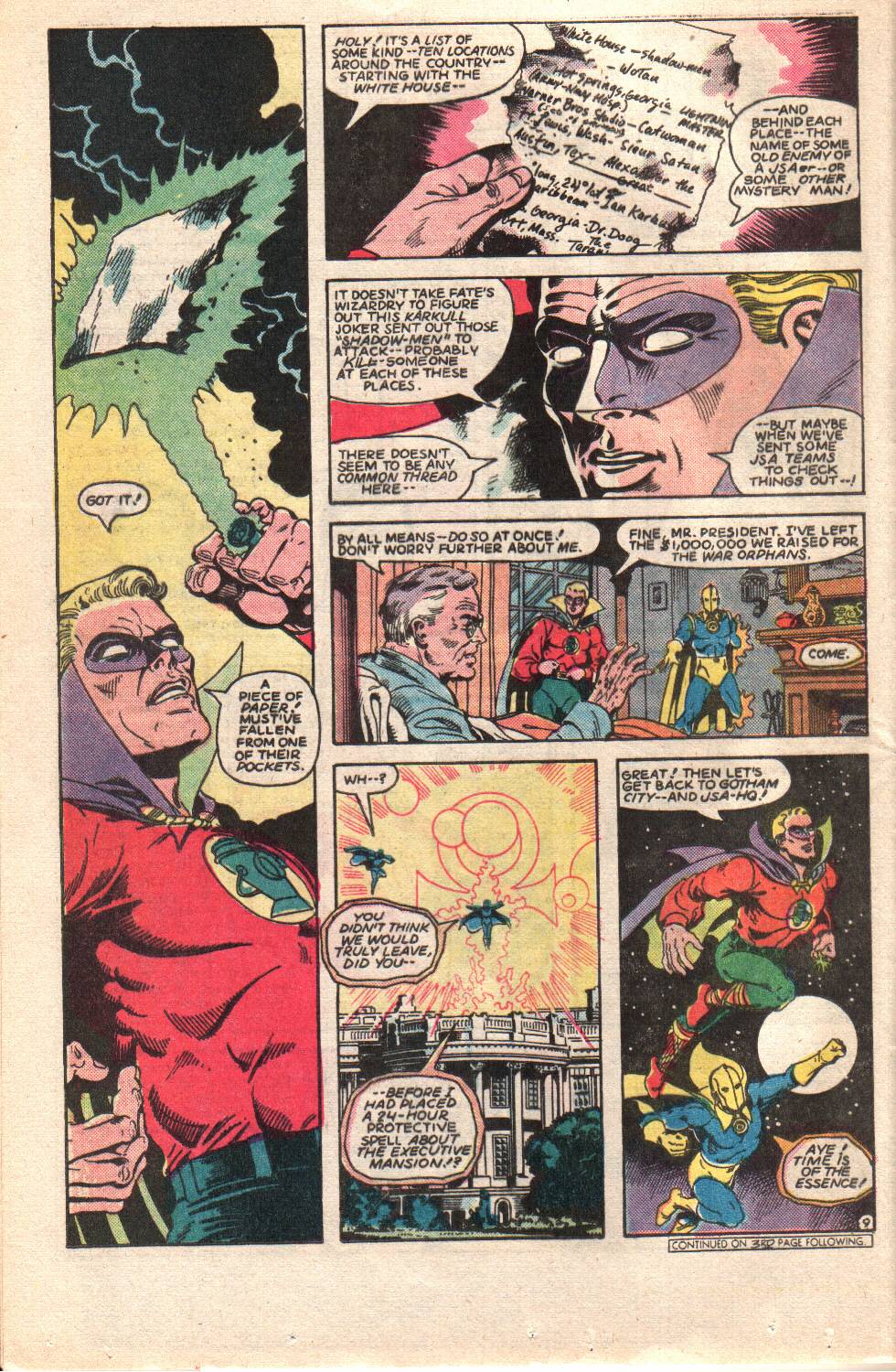 After they split up, we meet the villains... 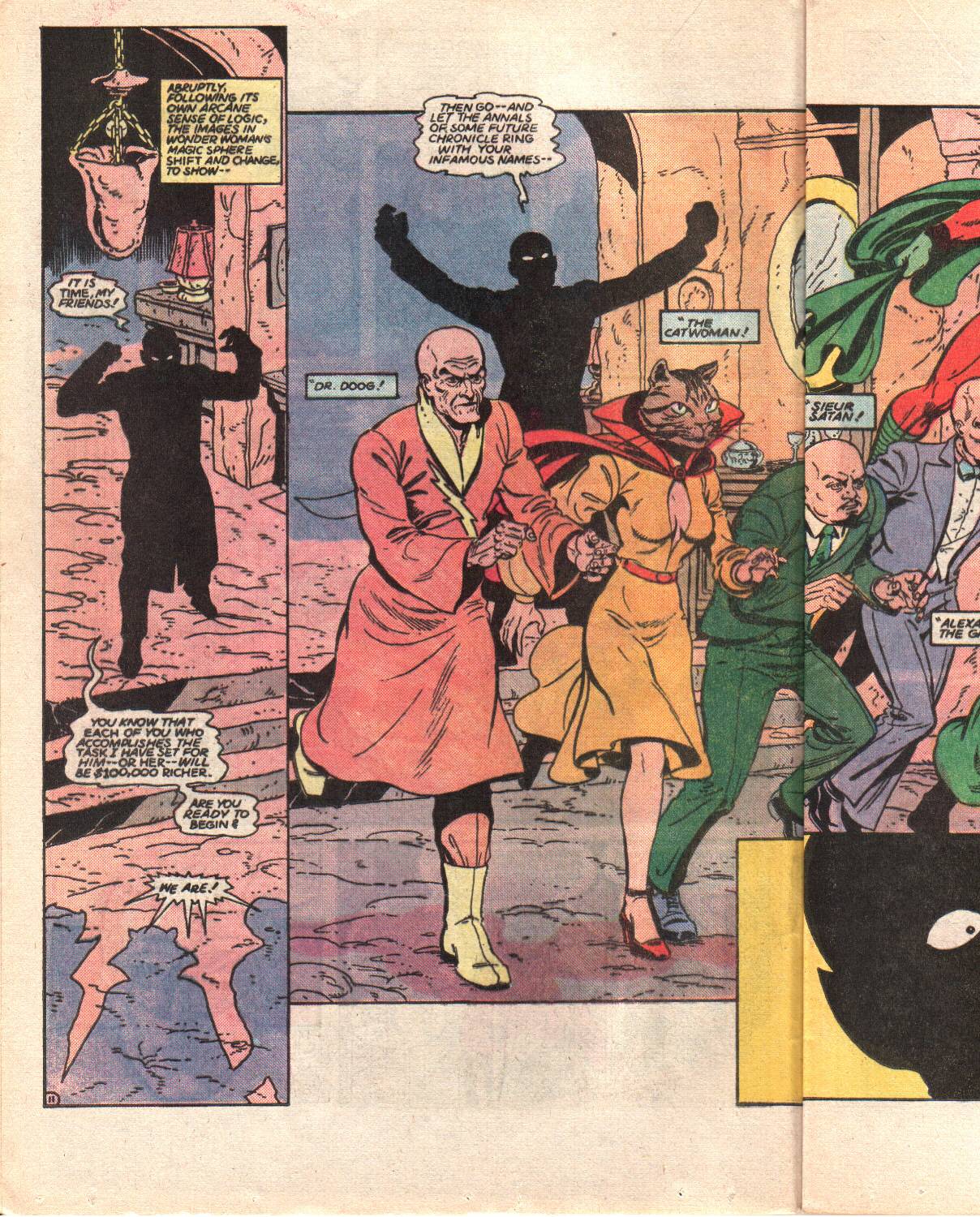 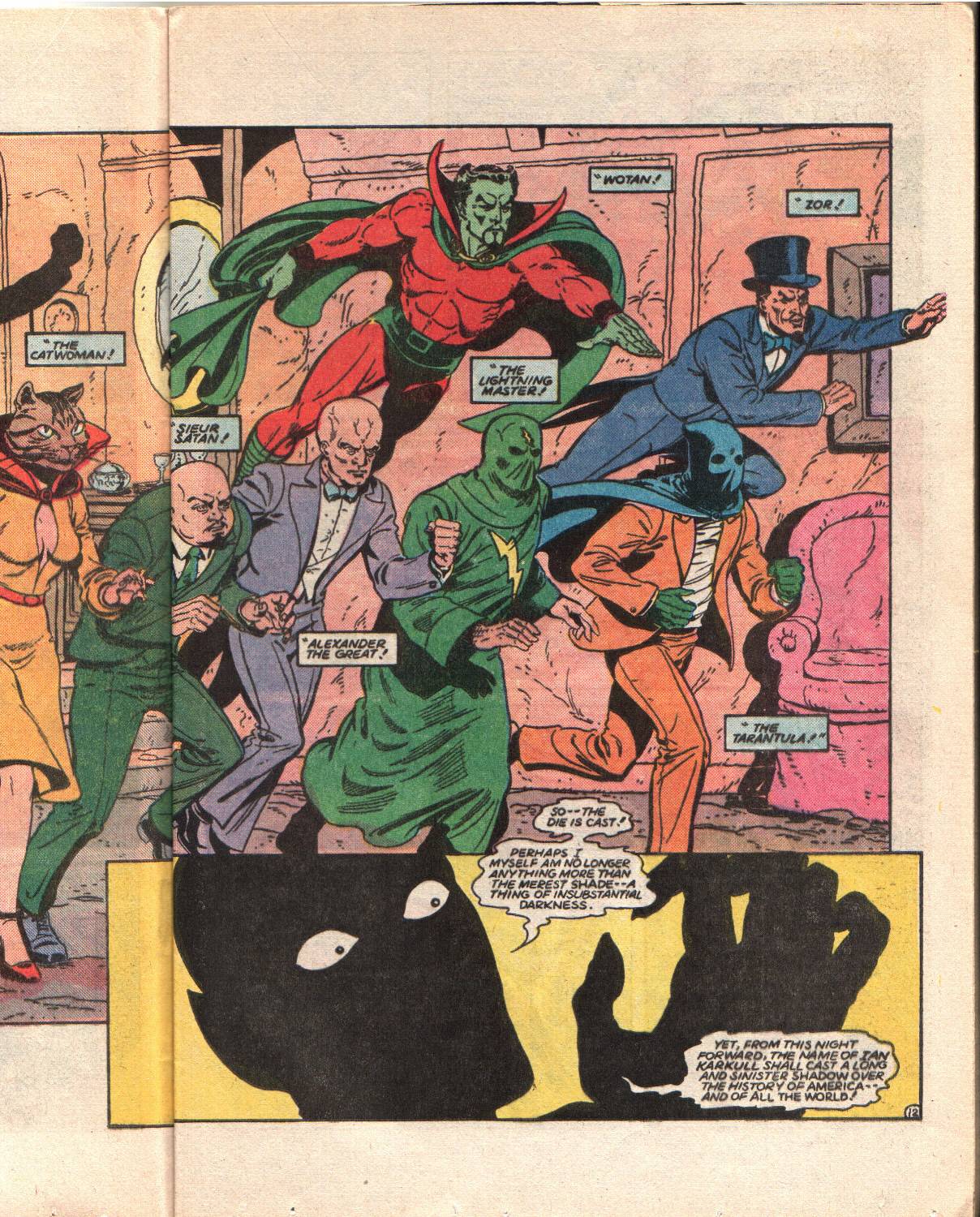 Dr Doog (fought Starman, in his debut), Catwoman, Sieur Satan (fought the Flash), Alexander the Great (fought Hawkman on his 2nd mission), Lightning Master (fought Superman in Supes #14), Tarantual (fought Sandman in his debut, not John Law), Wotan, Zor (fought the Spectre). Superman goes first and faces Lightning Master in hot Springs, AK. He saves Lois Lane after her plane is hit by lightning, then dumps her when she gets bitchy and goes after LM. He was a bit of a rick (spelled with a silent p) in those days. Lois parachutes and LM cackles... 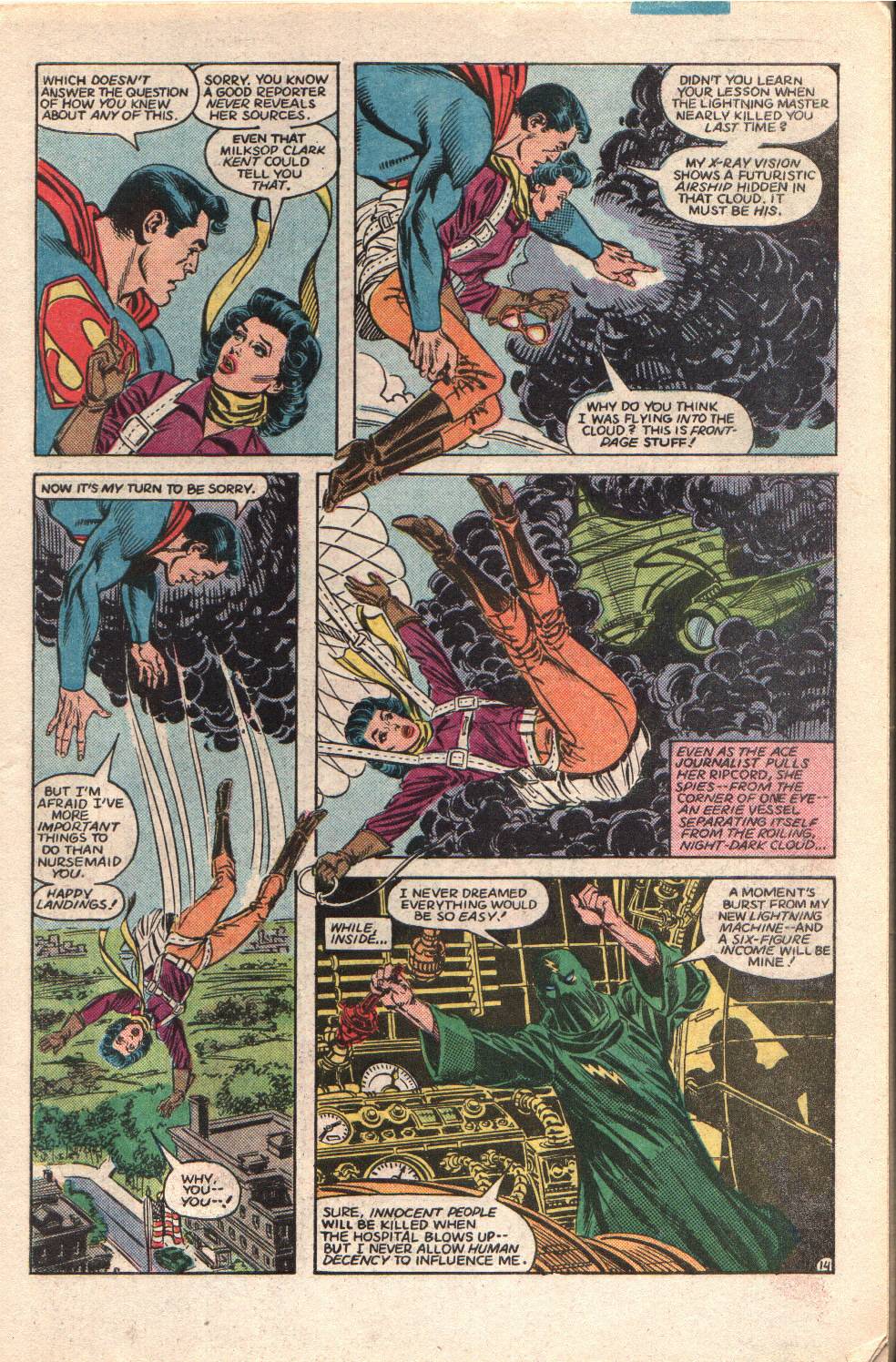 LM's "futuristic airship" looks very "enterprising." Superman gets zapped about by lightning, before Johnny Thunder and T-Bolt come to the rescue. He then punches out the ship and re-rescues Lois. Hawkman & Hawkgirl stop Alexander, while Spectre beats Zor and Atom & Sandman knock out Tarantula. Flash heads to Ft Lewis, Washington, where the new camp commandant is arriving, with his wife. 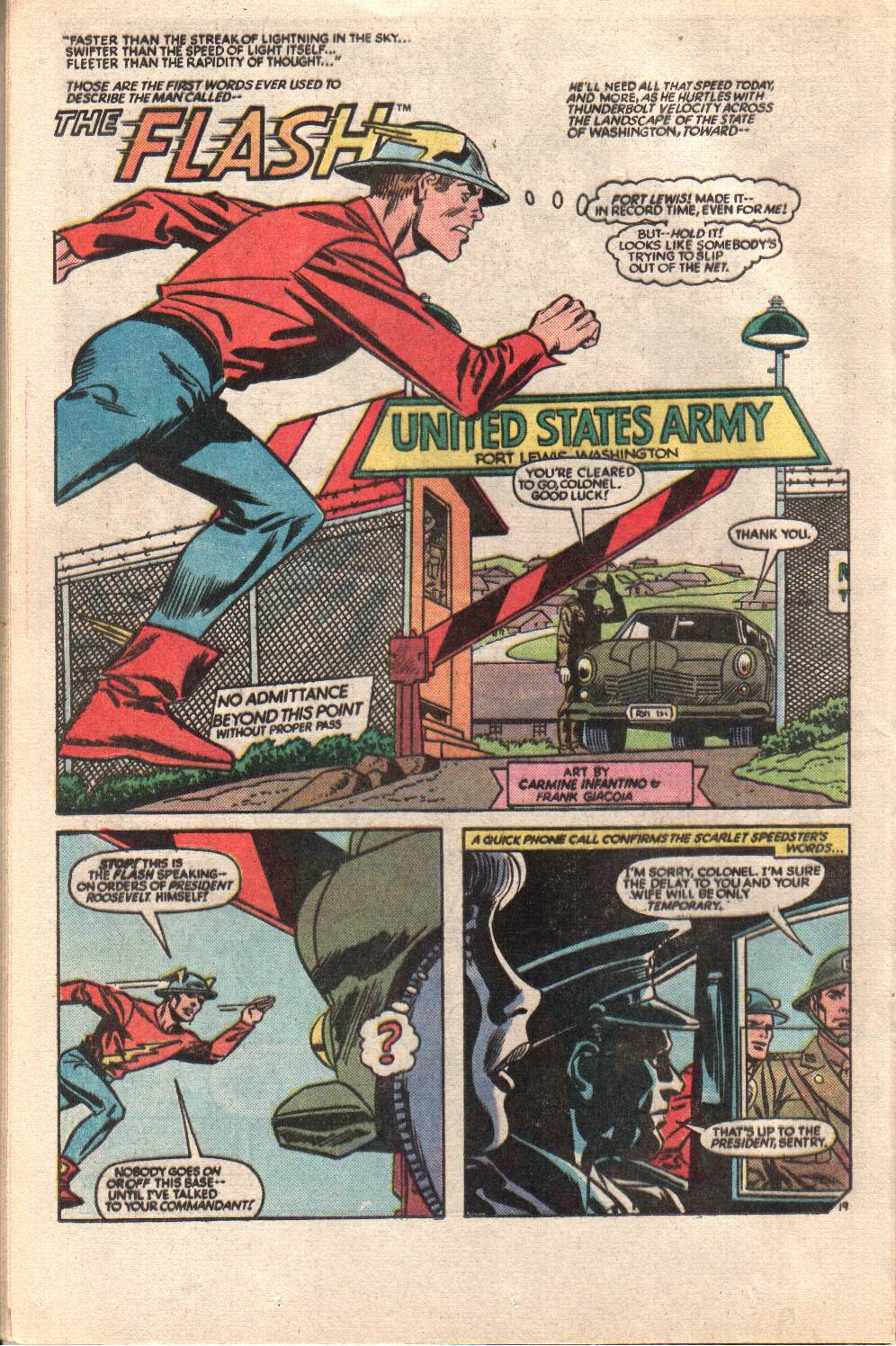 Flash faces Sieur Satan and rescues Joan Williams (the future wife) and prevents the death of the commandant. Batman goes to Hollywood and saves a B-movie actor from being killed by Catwoman, in her old kitty mask. 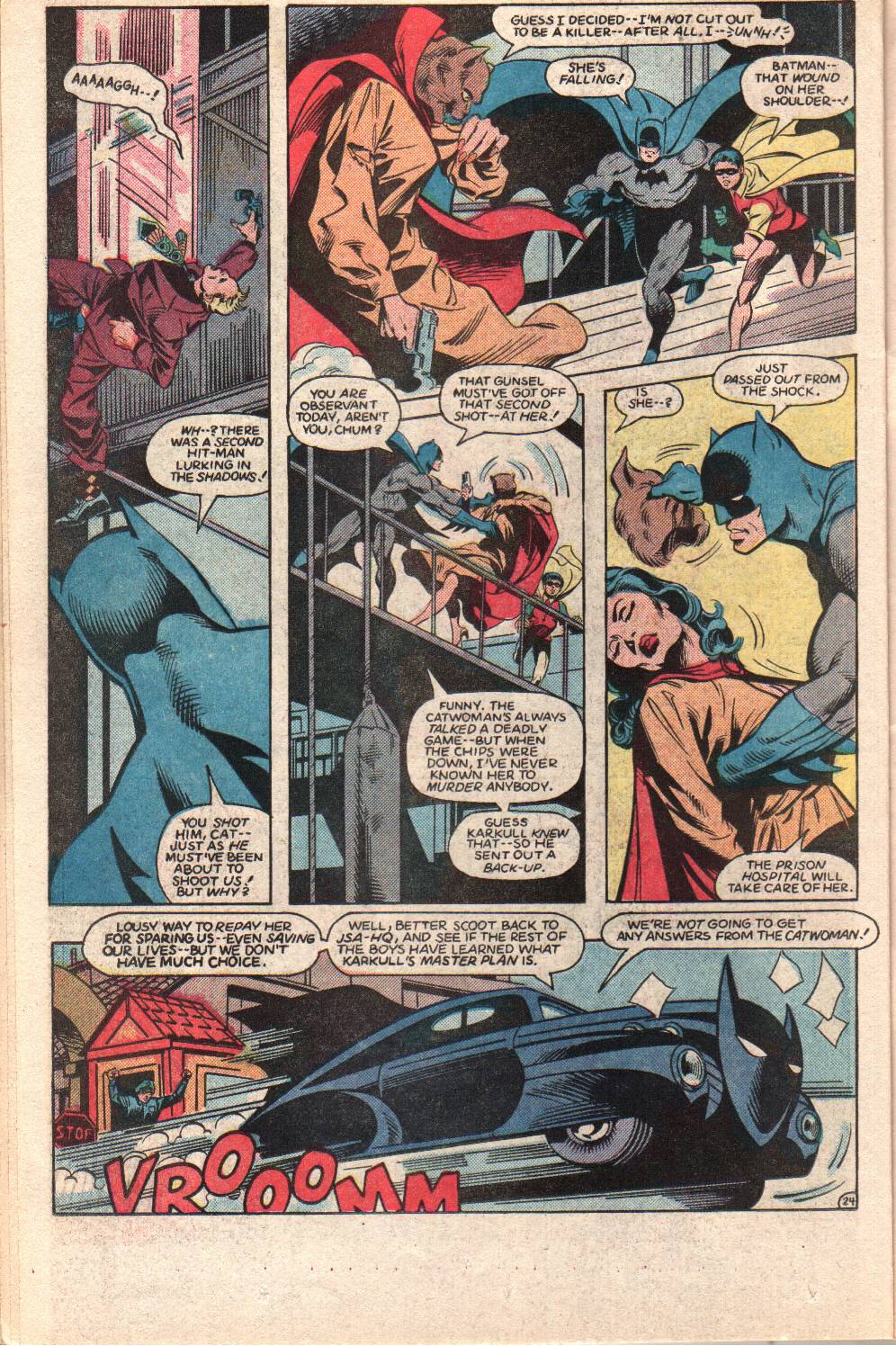 GL fails to stop Wotan from killing an unknown kid. Hourman faces Dr Doog, but is having issues with Miraclo and Starman has to help him out. 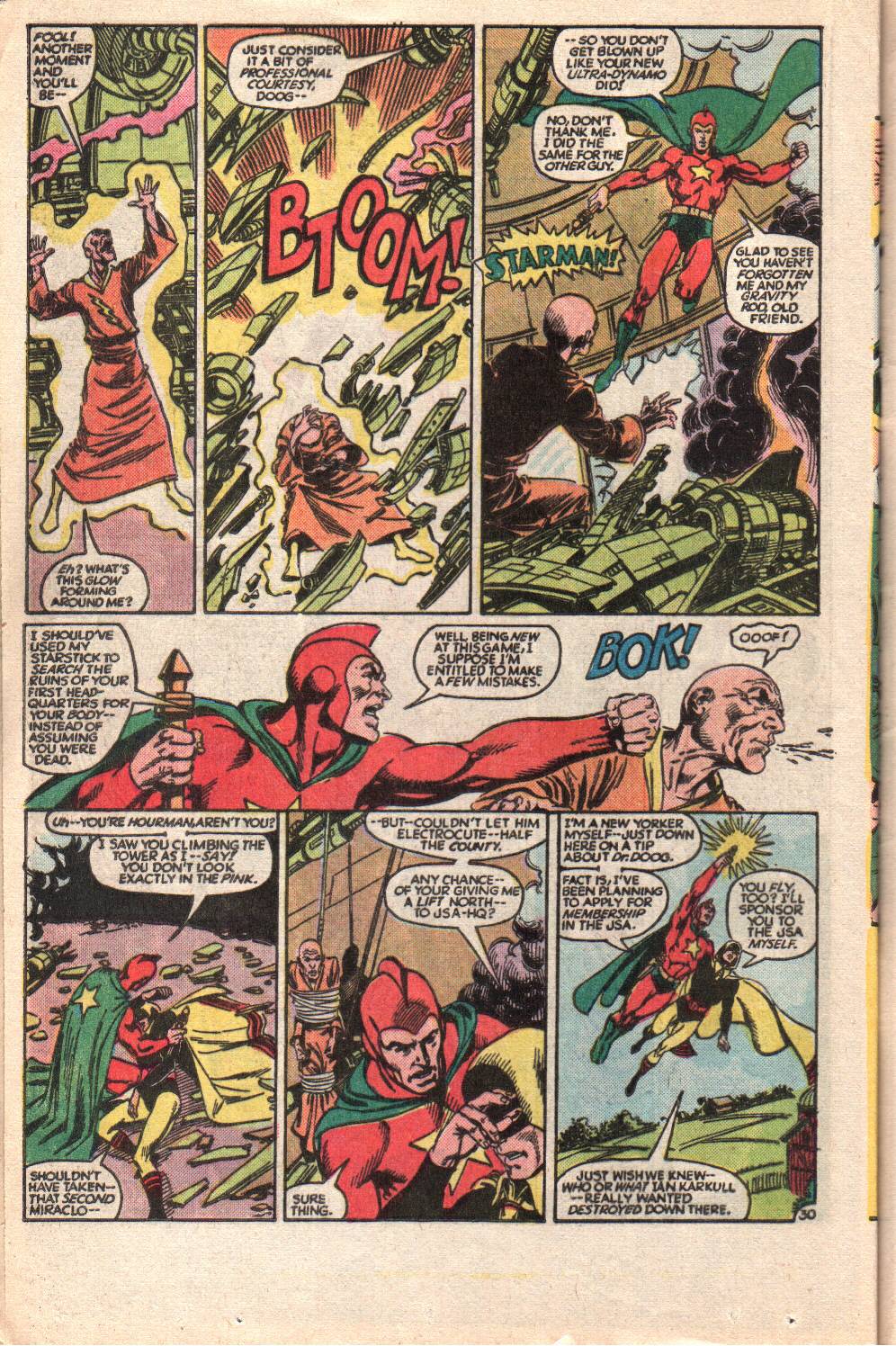 Dr Fate faces Karkull, himself, who wants the helmet of Nabu. Dr Fate is on the ropes; but, Nabu unleashes power, which brings the rest of the JSA there to beat up Karkull. He's defeated, Hourman steps down as JSA chariman to deal with his Miraclo addiction. Starman joins, GL drops down to honorary status and Dr Fate decides to do something about his over-reliance on the manipulative Nabu. Wondy and Tarantual never figure out the meaning of the paperclips; but we do, when we see them at the end... 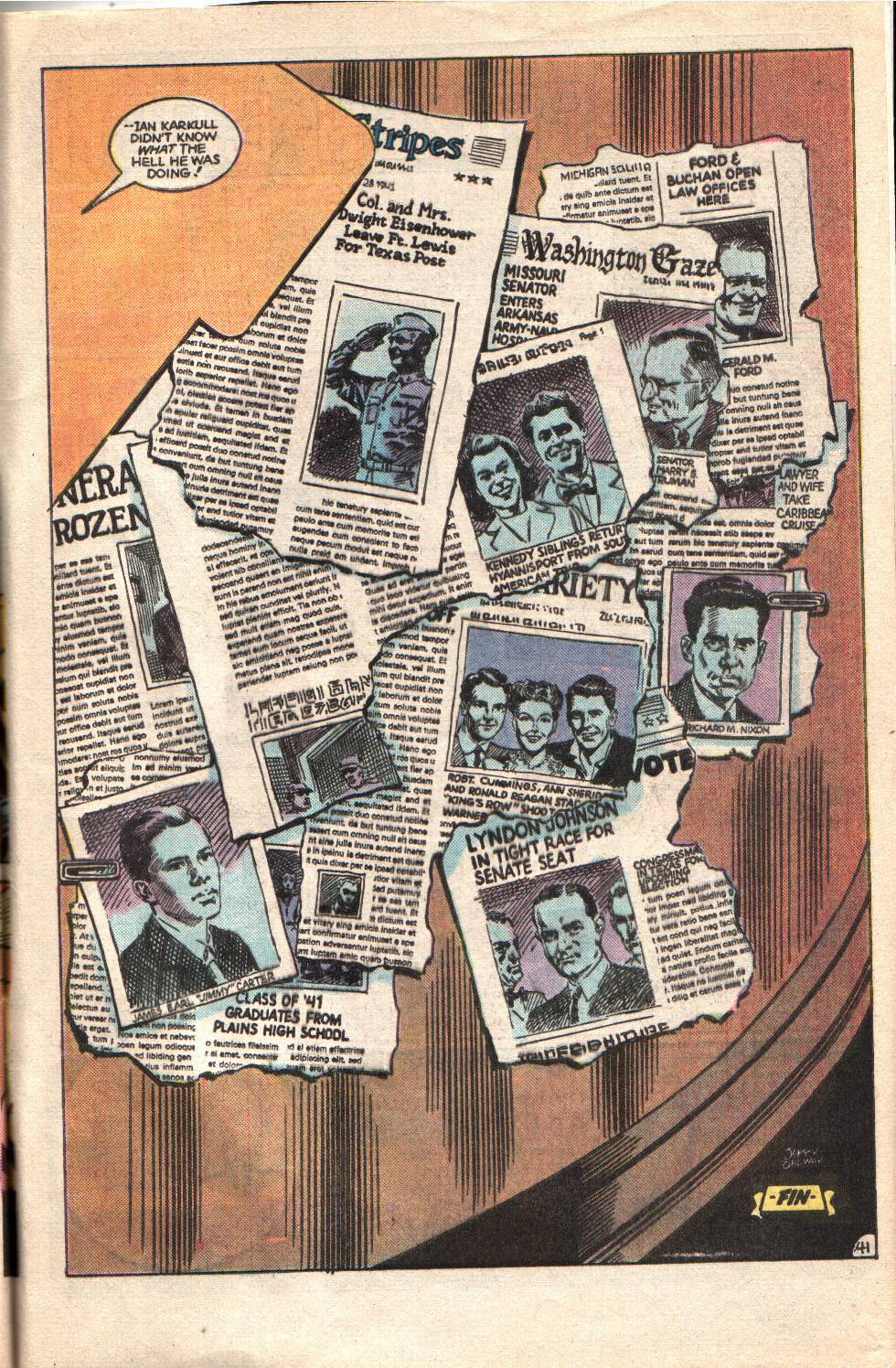 They are the next 8 Presidents of the United States, plus some unnamed 9th, who died so that George Herbert Walker Bush could be president (we are still in Reagan's first term, on this issue). They were: Senator Harry S. Truman, Col Dwight David Eisenhower, John F Kennedy (fresh out of college), Lyndon B Johnson (losing a senate race) Richard M Nixon (on a Caribbean cruise), Gerald R Ford (setting up a law practice), James E Carter (graduating high school) and Ronald Reagan (filing Kings Row). Bush was 16, but would become a naval aviator, during the war. Thoughts: This is a bit overly convoluted and is yet another continuity "fix" from Roy, to explain why Hourman abruptly stepped down as JSA chairman and Green Lantern became an honorary member, as well as Starman becoming a new member, between All-Star 7 and 8. Given that the bulk of the audience for this probably never saw those stories, who cares? Well, Roy did. The story is typical of the type of thing in All-Star, with some big threat at the beginning, a splitting of the team, their individual fights, and a reunion at the end. The villains are barely 3rd string, let alone major threats. Karkull doesn't really do much, aside from F with Dr Fate, but gets beaten. The energies released in the fight are retconned into what kept the JSA so young, when they et up with the JLA and, eventually, had kids who formed Infinity, Inc. This was unceremoniously stripped away by Extent (aka Hank "Hawk" Hall, aka the Monarch), at the end of Zero Hour and a couple of people died. That was all part of an editorial FU to the JSA, carried out by factions who didn't like the older heroes, despite the relatively new Justice Society comic having a pretty loyal and growing fanbase and good critical praise. Mike Parobeck was becoming a bit of a fan favorite, which would be cemented on Batman Adventures. The artists are paired up with their main characters, with Wayne Boring handling Superman, Rick Hoberg gets the JSA, Richard Howell handles the two-page spread of Hawkman, Spectre, Atom & Sandman, Don Newton does Batman, Carmine Infantino the Flash, Mart Nodell GL (for the first time in decades), George Perez does Hourman and Starman, and Kieth Giffen handles Dr Fate. Giffen is doing his murky, Jose Munoz thing, though I preferred his Legion stuff, which was a bit sleeker. Nothing of real consequence, other than Roy indulging his inner fanboy. Not sure how well this sold. It's a bit of a letdown from the previous 2. This is also the last All-Star Squadron Annual. Historical Notes As mentioned, the targets are all future presidents. Truman was a senator, from Missouri and would become FDR's running mate, in 1944, as a compromise, as Harry Hopkins was too liberal for Southern Democrats, who threatened to break with the party. He would inherit the presidency when FDR died and would make the fateful decision to use the Atomic Bomb. Eisenhower was a Colonel assigned to Fort Lewis, though he would soon go to Ft Sam Houston. he was promoted to Brigadier General in October, after his performance in the Louisiana maneuvers, a war game which tested the US Army's ability to potentially fight in the war in Europe. It led to much overhaul of doctrine, as it revealed many deficiencies. After Pearl harbor, Eisenhower was called to the War Department to serve under Gen Marshall, before being assigned to command the Allied Expeditionary Forces in operation Torch, the landings in North Africa. John F Kennedy had just graduated from Harvard and taken a vacation. He would enlist in the US Navy and attend OCS, first stationed in Washington, then reassigned to the Pacific, as a PT Boat skipper, in the Solomons. His vessel, PT 109 was rammed by a Japanese destroyer and he helped rescue much of his crew and get them to safety on a nearby island. he then made several swims to attempt to signal a rescue party, before making contact with natives and conveying a message carved on coconuts. Kennedy was cited for his leadership and bravery, which resulted in successful rescue of his crew. He would go on to become a senator, before running for the presidency. Johnson was a representative, but lost an election for the US Senate. he would end up in the Senate, then as Kennedy's running mate, assuming the presidency after the assassination. He successfully ran for office in 1964, but declined to run in 1968, largely due to the Vietnam War and the likelihood of a defeat. Richard Nixon worked in the Office of Price Administration, before applying to the US Naval Reserve, in 1942. he served in the Pacific, in a rear echelon role, supervising cargo loading and unloading and manifest for transport aircraft. He was elected to the US House in 1946 and the Senate in 1950. he became Eisenhower's running mate in 1952 and ran against Kennedy in 1960. he ran again and won in 1968 and won re-election in 1972. he resigned the office in the wake of the Watergate Scandal, as articles of impeachment were being prepared in the House and a polling of senators revealed a likelihood he would be removed from office. Gerald Ford served in the US Navy, on the USS Monterey, in the Pacific, taking part in landings at Kwajalein and Eniwetok and the Battle of the Philippine Sea. He was elected to the House in 1948 and served on the Warren Commission, investigating the assassination of Pres. Kennedy. When Spiro Agnew resigned in disgrace, he became the Vice President, under Nixon. Upon Nixon's resignation, he assumed the presidency and tyhen lost the 1976 election. he is the only man never to be elected to the Vice Presidency or Presidency. James E "Jimmy" Carter attended the uS Naval Academy during the war and served on active duty after. He was part of the fledgling nuclear Navy, under Adm Hyram Rickover (a grade A nutjob, but father of nuclear propulsion in the US Navy). He was elected to the Georgia State Senate in 1962 and Governor in 1972. In 1976 he surprised the nation by winning the Democratic nomination for the US Presidency and defeated Gerald Ford in a close election. He was president during the Iranian Hostage Crisis, and while the Soviet Union invaded Afghanistan. He also inhereted a post-Vietnam economic recession, the worst since the Great Depression. These three factors led to him losing to Ronald Reagan. Reagan graduated from Eureka College and first worked in radio, before becoming a film actor. His first screen credit was in 1937 and he was a supporting actor to friend Errol Flynn in a couple of movies, while starring in B-Movies. During the war he served in the Army Reserve and worked in public relations and military film units. He was elected president of the Screen Actors Guild and was involved in efforts to by conservative members to root out supposed communists, cooperating with HUAC on the Blacklist. He was elected governor of California in 1966 and ran for the presidency in 1976 and then again, successfully, in 1980, winning re-election in 1988. He survived an assassination attempt in 1981, but his later term involved several health scares, the Iran-Contra Scandal, and suggestions that he was already suffering from Alzheimers, for which he was ultimately diagnosed, in 1994. He was extremely popular during his presidency and oversaw an economic recovery, though a decline in US manufacturing and exports and a decline in real wages (the buying power of wages earned). Elements of the CIA and the Department of defense were involved in illegal arms sales to Iran, in exchange for currency that was funneled to the Contras, in Nicaragua, to fight the Marxist Ortega Government, which led to Congressional hearings. George HW Bush enlisted in the US Navy, on his 18th birthday and trained as a Naval aviator. He was assigned to fly the Grumman TBF Avenger torpedo bomber and his squadron was assigned to the USS San Jacinto, where he took part in bombings at Wake Island and was shot down, but rescued by the USS Finback. he would be awarded the Distinguished Flying Cross. He was reassigned to the San Jacinto, in preparation for the Invasion of Japan, when the Japanese surrendered, in the wake of the Atomic bombings on Hiroshima and Nagasaki. He was elected to the House in 1966 and was an advisor in the Nixon Administration, before becoming UN Ambassador. he was named Director of Central Intelligence in 1976. He ran for the Republican nomination in 1980 and became running mate to Ronald Reagan, serving as Vice President for both of his terms. he was elected to the presidency in 1988 and oversaw the US military operations in Panama and in Operation Desert Shield and Desert Storm. Despite great approval coming out of the Gulf War, a recession hurt him in the election and he lost to Bill Clinton. Ernst Rohm was an early ember of the Nazi Party. He served in the Wehrmacht in WW1 and the Reichswehr following the armistice, before joining a Bavarian freekorps, which helped put down the Munich Soviet republic, through force of arms. He joined the right wing German workers party, which became the Nazi Party, with Adolf Hitler as its leader. He participated in the Beer Hall Putsch, in 1923, seizing control of the German War Ministry, before Bavarian Police put the revolt down. Rohm was sentenced to 15 months in prison, but the sentence was suspended and he was put on probation. In 1930, at Hitler's request, he took over the Sturmabteiling, the SA, or the "stromtroopers." They were the muscle for the Nazis, engaging in street battles with communists and socialists, creating civil unrest which helped propel the Nazis to power. They were heavily involved in the harassment and beationg of Jews and other targets of the Nazis, culminating in Kristalnacht, when Jewish businesses and synagogues were attacked and smashed. Rohm had designs on the SA replacing the Reichswehr as the military of Germany, which earned them opposition from the powerful military factions in Germany. To gain the military's support, Hitler made promises to reduce Rohm's power and expand expenditures on the Army and Navy. On June 30, 1934, with trumped up "evidence," Rohm and leaders of the SA were rounded up by the SS and murdered, claiming they had been paid by France to depose Hitler. Himmler consolidated the power of the SS and became second to Hitler in the Nazi power structure, with control over the Waffen SS, the Gestapo, and other SS wings. August 1942: Mohandas Gandhi is arrested by British forces in Bombay. On the 13th, the All-Indian Congress passes a resolution which begins the civil disobedience movement against British rule. The US Eighth Air Force flies their first bombing missions over France. Casualties are high in the early stages of bombing raids, especially as the progress deeper into German territory and are forced to fly without fighter escort. The movie 12 O'Clock High is an excellent dramatization of the early learning curve within the bomber squadrons, as well as the qualities of leadership. 6 German saboteurs are executed after the failed Operation Pretorious, which placed agents in defense factories, for the purpose of sabotage. The FBI discovered the plans and turned several agents and rounded up others, with the end result that German operations in both the US and Great Britain are virtually destroyed or neutralized. On August 19, British and Candadian forces, plus a detachment of US Army Rangers, carry out the Dieppe Raid, the largest commando raid of the war. The operation was carried out to test the feasability of seizing and holding a port in occupied territory, for the purpose of launching an invasion of the continent. It was also intended as a morale boost. It turned into a fiasco. The plan called for landings along 6 beaches, but only 6 destroyers were provided for naval gunfire support, as the First Sea Lord was reluctant to expose capital ships (cruisers and battleships) to potential bombardment from land-based aircraft. The range of the destroyer's guns was only about 5 miles, vs over 20 for a battleship. Destroyers also gad fewer guns to bring into operation. Bombers were assigned to support, but without fighter escort. Intelligence of the area was poor and the summation of German strength was woefully inaccurate. The Germans were on high alert, thanks to double agents and increased radio traffic. Landings began at 0450, on Aug 19. The first wave ran into a German convoy and were attacked and the destroyers misidentified the fire as coming from ashore and did not move in to rescue the landing craft. At Yellow beach, commandos were unable to destroy shore huns, but sniping was effective enough to disrupt their use. However, commandos on Yellow 1 were cut off and forced to surrender, while only 18 got ashore on Yellow 2, and were eventually forced to withdraw. Orange Beach had the only success, led by Lord Lovat, who would lead British commando forces at Sword Beach, at Normandy. They succeeded in scaling a cliff and neutralizing a shore battery. At Blue Beach, Canadian forces were slaughtered by German artillery, after delays in landing them eliminated their smokescreen. They lost over 200 of 500 men assigned, and 264 captured. Green beach had similar problems, as landing craft drifted beyond their target and landed in the wrong area, forcing Canadian troops to have to cross a bridge to reach their objectives. the Germans had machine guns positioned to cover the bridge and halted their advance. Lt Col Charles Merritt won the Victoria Cross by repeatedly crossing the bridge to show it was feasible and spur on his men to get across. Only 341 men reached the landing craft for withdrawal. A slightly successful element of the raid was an attempt to infiltrate a radar expert into a German station to gain intelligence on their workings. The commando team couldn't get him inside their defenses, b; but, he did manage to sever their phone wires and forced them to communicate via radio, which was intercepted and recorded for study. The information gave a great insight into German radar installations and density and helped to develop jamming techniques. Red and White Beaches came under intense fire and the Canadians lacked armor support and their reinforcements were brought to bear too late. Again they suffered heavy casualties. Air operations proved effective enough to keep the Luftwaffe away from the area, during operations, one of the few successes. The Germans even captured copies of the Dieppe plans, which allowed them to study them and beef up defenses along the Atlantic Wall. The Allies learned everything not to do, which influenced planning for Normandy. On August 7th, the US Marines made their first landings int he island hopping campaign, in the Solomon Island Chain, at Tulagi, the Florida Island, and Guadalcanal. Tulagi had a large natural harbor and a Japanese seaplane base, while Florida Island dominated the harbor. 3,000 Marines landed at Tulagi and secured it in two days, all but wiping out the Japanese defense forces, after intense and difficult fighting. The Marines were largely uncontested at Guadalcanal and soon moved inland, aiming to capture the Japanese airfield that was under construction, which led to it being hastily added to the targeted islands. The marines made steady advance and secured the airfield by 1600 on the 8th. The captured food and equipment left by the Japanese, after heavy naval bombardment led the construction units to flee the area. The Japanese launched aircraft from Rabaul and attacked the supporting ships damaging a destroyer and setting a transport on fire (and ultimately sinking it). The US lost 19 fighters in air engagements, to the Japanese 36. Adm Fletcher, worried about the loss of aircraft, withdrew his task force, while still unloading men and equipment. On the night of the 8th, a convoy of ships from Rabaul attacked the US escorts and sank 4 cruisers (1 Aussie and 3 Yank) and damaged 3 other ships, but did not attack transports when they had the opportunity. the Marines were left without heavy equipment, ammunition and rations. The Marines worked quickly and extended tremendous efforts to set up a defensive perimeter around Lunga Point and the airfield and to finish the airfield to allow air transport resupply and fighter protection. They moved supplies within the perimeter in staging dumps. By the 18th, Henderson Field (named after a downed pilot at the Battle of Midway) was operational. The Marines were surviving on the 5 days worth of rations they came ashore with and captured Japanese rice, subsisting on 2 meals a day. Dysentery also affected 1 in 5 Marines. The Japanese would launch a counter attack on the 21st, at what was known as Alligator Creek, in the Battle of Tenaru. A coastwatcher spotted their movements and warned the Marines, who were prepared with artillery and machine guns and slaughtered the Japanese, inflicting 700+ casualties on the force of 900, with the loss of 60 Marines. Guadalcanal would continue to be a battle ground until the end of the year. Witnessing the Battle of Tenaru was Marine PFC Robert Leckie, who wrote of the killing in his memoir, A Helmet for My Pillow. Leckie was a sportswriter who enlisted in the Marine Corps after Pearl Harbor and would serve at Guadalcanal and Cape Glouscter, in New Britain (off New Guinea) and then at Peleliu, where he was wounded. He was driven to write his memoir after walking out of a showing of the movie version of South Pacific, telling his wife Vera that people had to know the truth about the fighting. His book would form part of the research material for the HBO mini-series, The Pacific. Leckie would go on to wrote several books of US military history, from the French & Indian War on up through Vietnam. I have read his George Washington's War, covering the Revolution, and his overall history of WW2, which are excellent general histories of those subjects. Leckie also wrote several novels and works for children. The last ite, is the Makin Island Raid. The US Marines eventually acted upon suggestions from LTCol Evans Carlson to create the 2nd Raiding Battalion, to employ training and disciplinary techniques he observed with Mao's forces in China. His men were trained in long, hard marches, living on a diet of rice, bacon and raisins, as the Japanese, and to act as a cohesive unit. Operational plans were dissected by all ranks, with everyone free to speak. They espoused gung ho, or fighting spirit, a term which was used in a derogatory manner by other elements of the Marines who disliked the radical Carlson and his men. Carlson had the advantage of a friendship with FDR's son, which got him support at the War Department, which ruffled feathers. A plan was put together to land an element of the Marine Raiders on the Makin Island atoll and attack the garrison there, launching rubber rafts from the USS Nautilus. The plan called for landings at two beaches; but, failures of outboard motors and heavy surf lead Carlson to land all of his men on one beach. A lieutenant Peatross and his 12 men didn't get the word and arrived at their designated landing area nd moved inland. The main force engaged the Japanese and met heavy resistance, but wiped out the Japanese, while Peatross' group arrived behind the Japanese and finished them off. Withdrawing the men proved difficult. Peatross and his men withdrew as planned, after never making contact with Carlson. Heavy surf inhibited Carlson's group and many had to abort. A second attempt was made in the morning but only 7 boats made it to the sub. The sub sent a rescue boat, with a rope line, to make transit easier, but the arrival of Japanese planes forced the sub to crash dive. The sub resurfaced after dark and the Marines finally made it off the island, though 9 were unwittingly left behind. The raid got great press coverage as a morale boost, though it held little strategic value. however, they were the first group to successfully engage the enemy and defeat them, as fighting on Guadalcanal was still raging. Carlson's methods were heavily criticized within the Marine Corps and no new raids were planned. However. the 2nd Raider Battalion was used to conduct deep penetration patrols on Guadalcanal, where they proved very effective in fighting the Japanese and carrying out reconnaissance. It was here that the marine Raiders really built their name.
|
|
|
|
Post by codystarbuck on Aug 26, 2020 20:34:32 GMT -5
ps The movie Gung Ho (not the Michael Keaton one), starring Randolph Scott, dramatizes the Makin Island Raid, not long after it occurred. A young Robert Mitchum is seen in scenes where potential raiders are interviewed, by Carlson. As it was a wartime film, it tends to inflate the importance of the raid and its success, as no prisoners were taken and little intelligence gained. its success lay solely as a morale victory. The movie is decent, if a bit slow in early stages. It does illustrate the difficulty in the extraction of the raiders.
The Marine Raiders would become one of the first special operations units in the uS military, in the war, with the US Airborne and US Army Rangers soon joining them. Airborne would prove itself at Normandy and in Holland, then again in the Battle of the Bulge.
The Rangers made their name at Point du Hoc, at Normandy, then in Korea and Vietnam.
The Army would develop an idea along Carlson's lines and create the Alamo Scouts, an offshoot of the Rangers, which carried out reconnaissance in the Pacific, particularly in the Philippines. They also created the nucleus of the rescue force that liberated the POW camp at Cabanatuan, on Luzon. Word arrived that the Japanese had begun murdering prisoners in their camps, ahead of the US advance. A rescue mission was quickly put together and the Alamo Scouts, under Lt Col Henry Mucci, along with Filipino guerrillas, carried out the rescue and extraction of the prisoners, in the first attempt to rescue American POWs from captivity.
|
|
|
|
Post by codystarbuck on Aug 30, 2020 16:25:40 GMT -5
All-Star Squadron #36 Captain Marvel vs Superman The greatest grudge match of the century; but, DC Comics is booking it, so guess who's going to "do the job?" Creative Team: Roy Thomas-writer/editor/dreamer, Rich Buckler-pencils, Richard Howell-inks, Cody Weiss-letters, Carl Gafford-colors Synopsis: Superman, Batman, Hawkman, The Flash, Green Lantern and Wonder Woman have been assembled; but, this is Earth-2, 1942. This is the Justice Society of America! 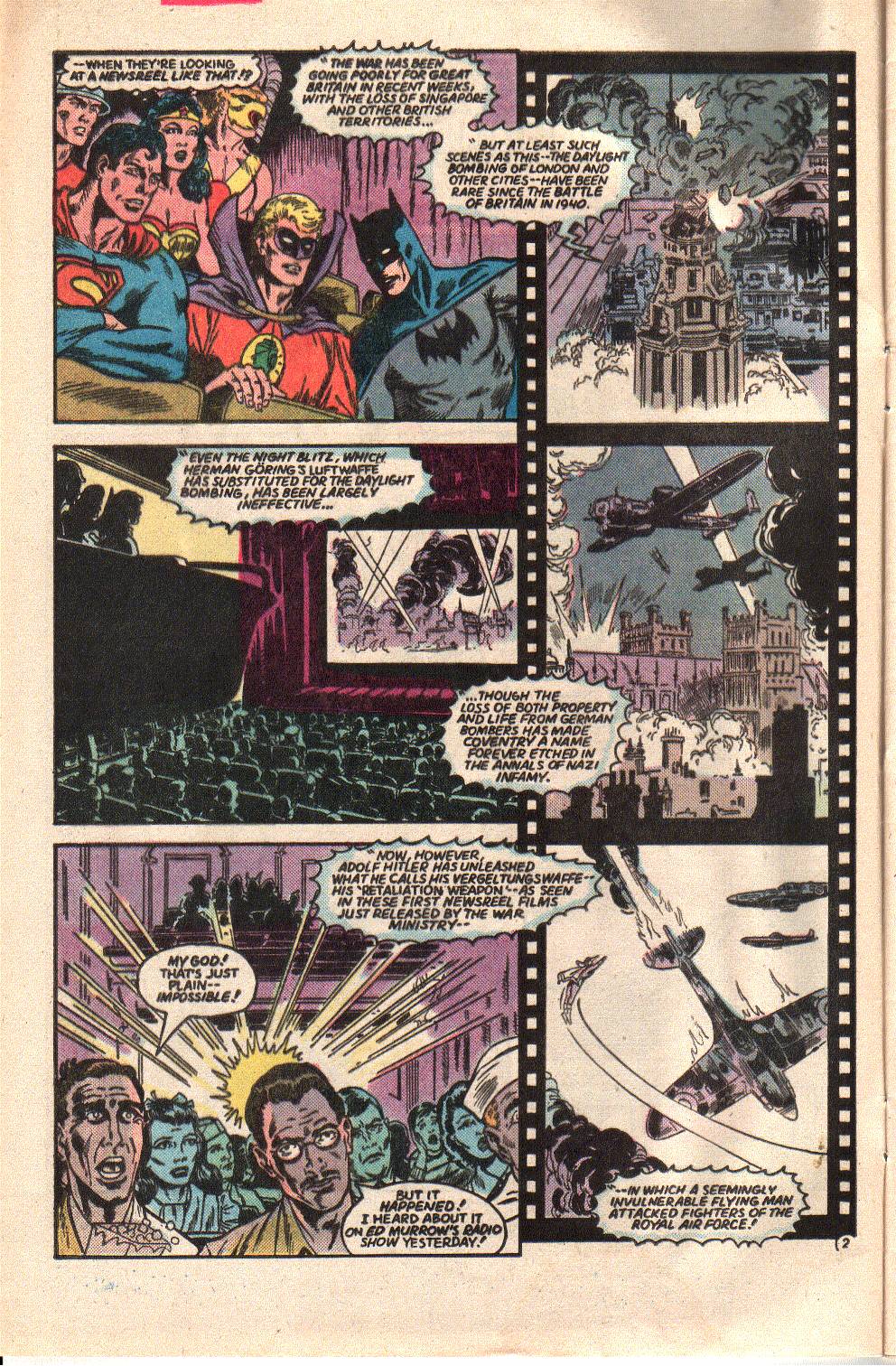 They watch newsreel footage, from Britain, as scenes unfold of the German's latest weapon: a flying super being... 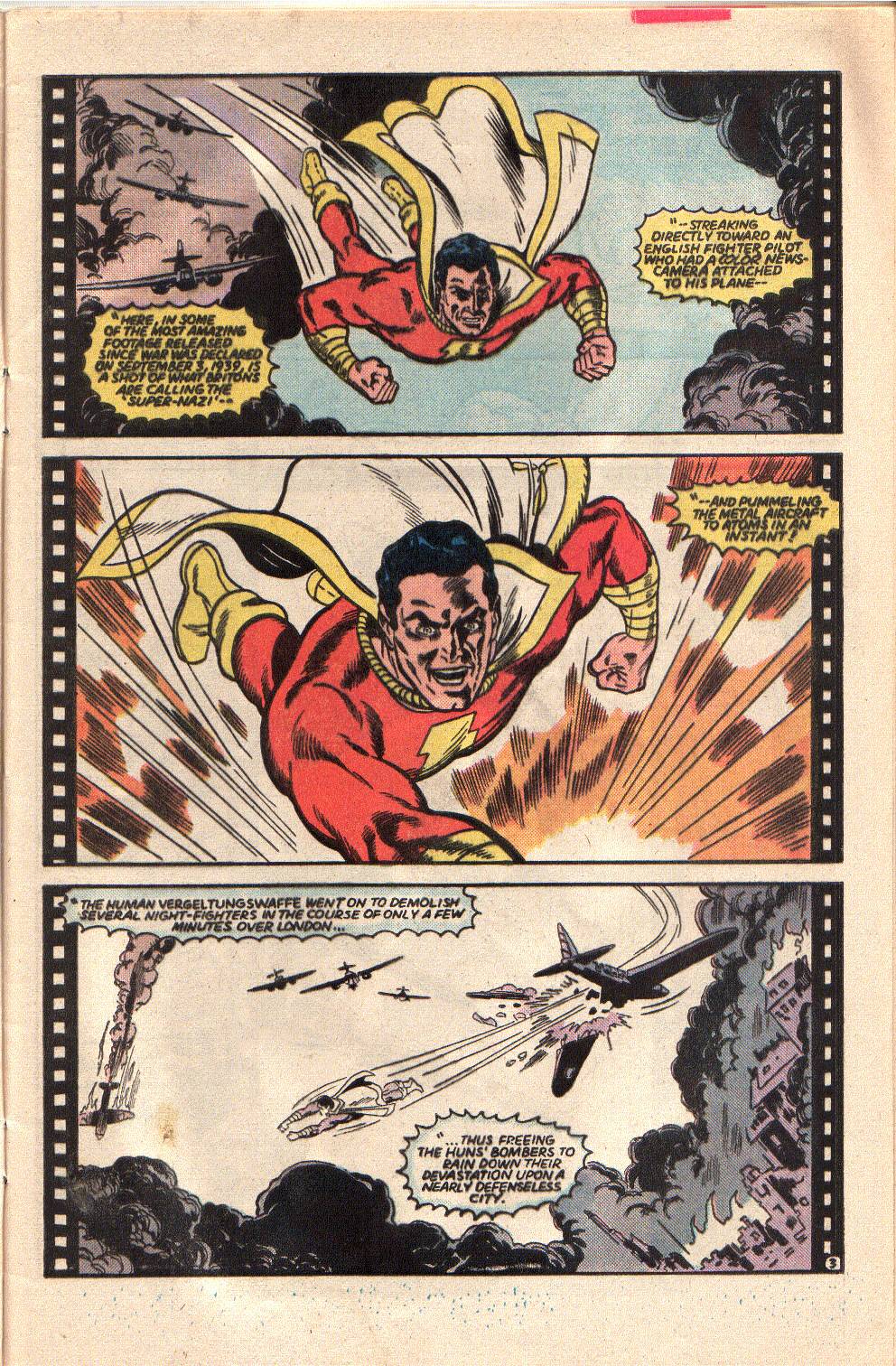 The figure destroys aircraft; but, lets the pilots parachute to safety. Bullets do no harm. Churchill sends up The Shining Knight to face him and his enchanted lance has some effect, but does not defeat the man. The flying man is stunned and Sir Justin draws his enchanted sword and continues the attack, but the flying figure is ready. He unseats Sir Justin, who plummets earthward, saved by Winged Victory, who dives after his master... 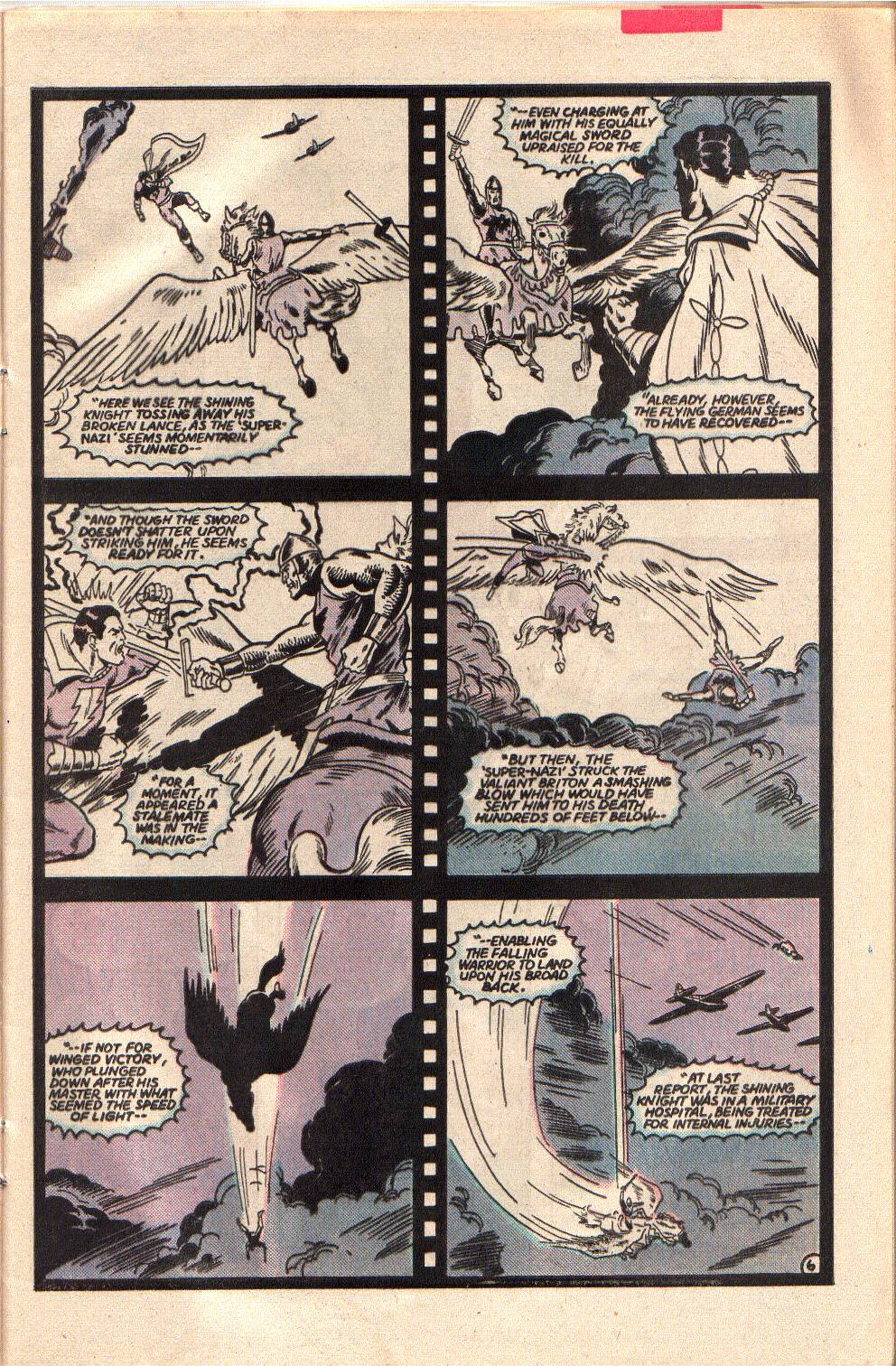 The screen finishes with footage of another weapon sent against the Nazis, the Blackhawks. Superman is angry and downcast. The term "Super-Nazi" hits too close to home. He wants to do something about it. Plastic Man, the FBI liason to the All-Star Squadron, turns up to tell them they are wanted at the White House. As the walk past a newsstand, Superman grabs a comic, featuring Captain Marvel and points to him as the Super-Nazi. It makes no sense. Hawkman (and Roy) points out that the idea o a "superman" didn't originate with the Man of Steel, that even Nietzsche had written of the "ubermensch." Superman burns the comic with his heat vision and takes off for London. The debate lasts 2 seconds and the JSA follow. They miss seeing two figures who wave to them, trying to attract their attention... 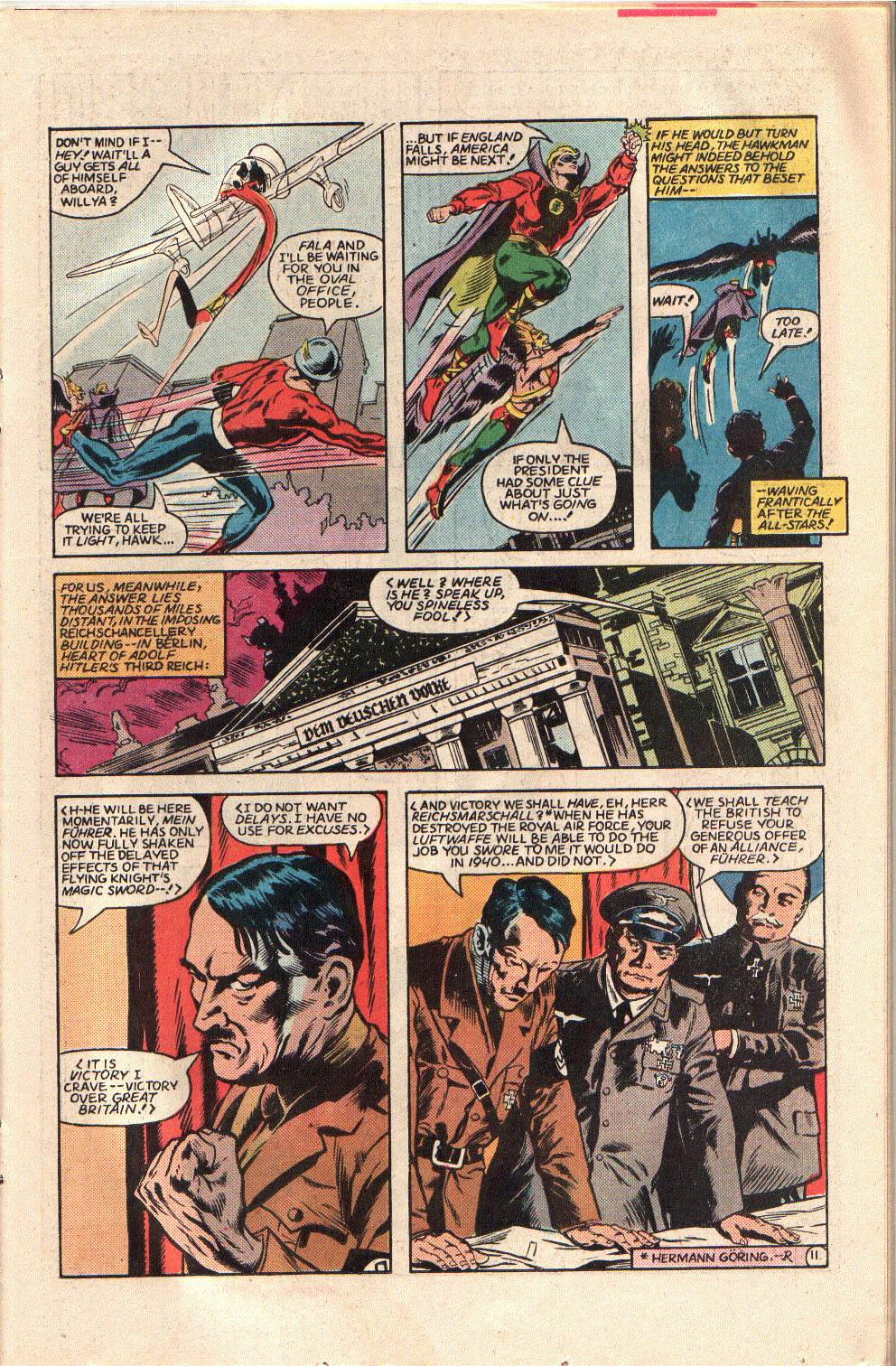 In Berlin, der fuhrer waits the Super-Nazi, while Goering sucks up. Finally, Hauptmann Wunder arrives... 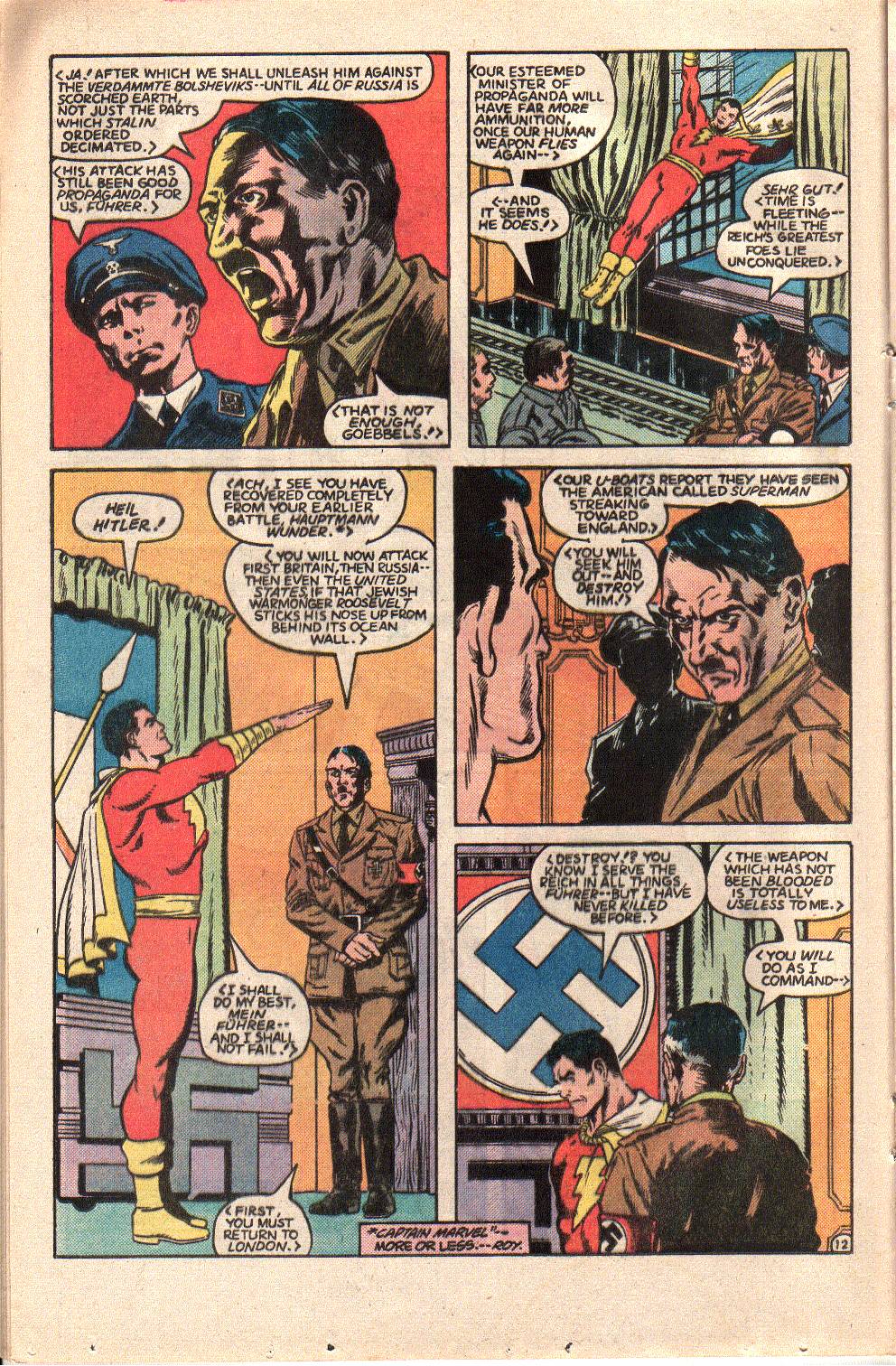 They have reports of Superman crossing the Atlantic and Herr Schickelgruber orders Der Großer Roter Käse to go meet him and kill him. Hauptmann Wunder is a bit reluctant to kill and Hitler rants at him. He then meets with the engineer, Gootsden, who seems to be at the heart of this. They go into the next room, where a boy is bound and gagged with iron... 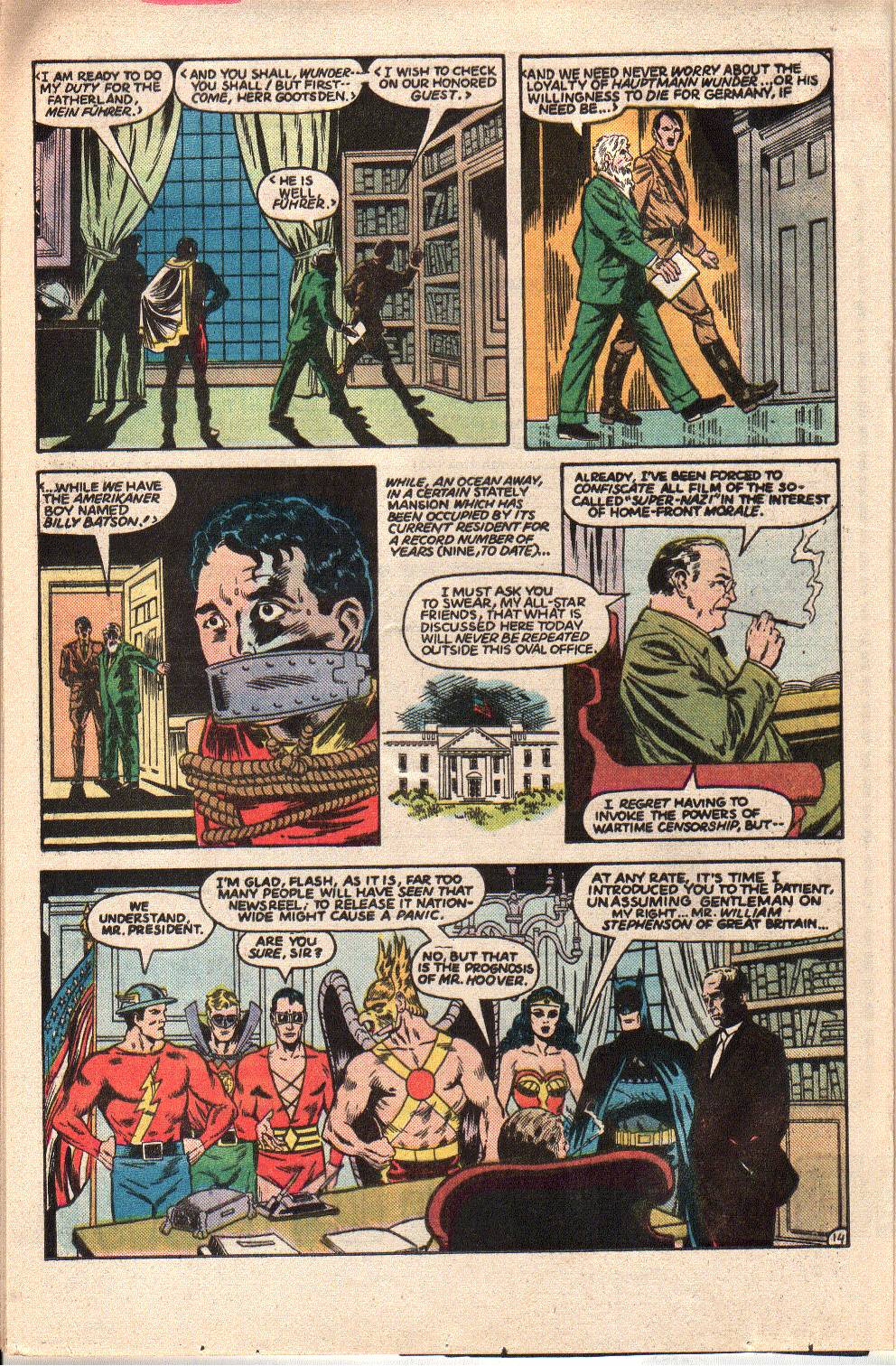 At the White House, the JSA meet with FDR and he tells them he invoked his war powers and confiscated all copies of the newsreel, for morale. he then introduces them to The Man Known as Intrepid, William Stephenson. He briefs the JSA; but we are kept out of the loop. Meanwhile, Superman arrives in London, to face an anti-aircraft barrage. He flies past and lands at a hospital, where he finds Sir Justin. Sir Justin briefs him on his battle with Hauptmann Wunder and describes how he seemed vulnerable to magic. They are interrupted by an air raid and the Mountain has come to Mohammed. 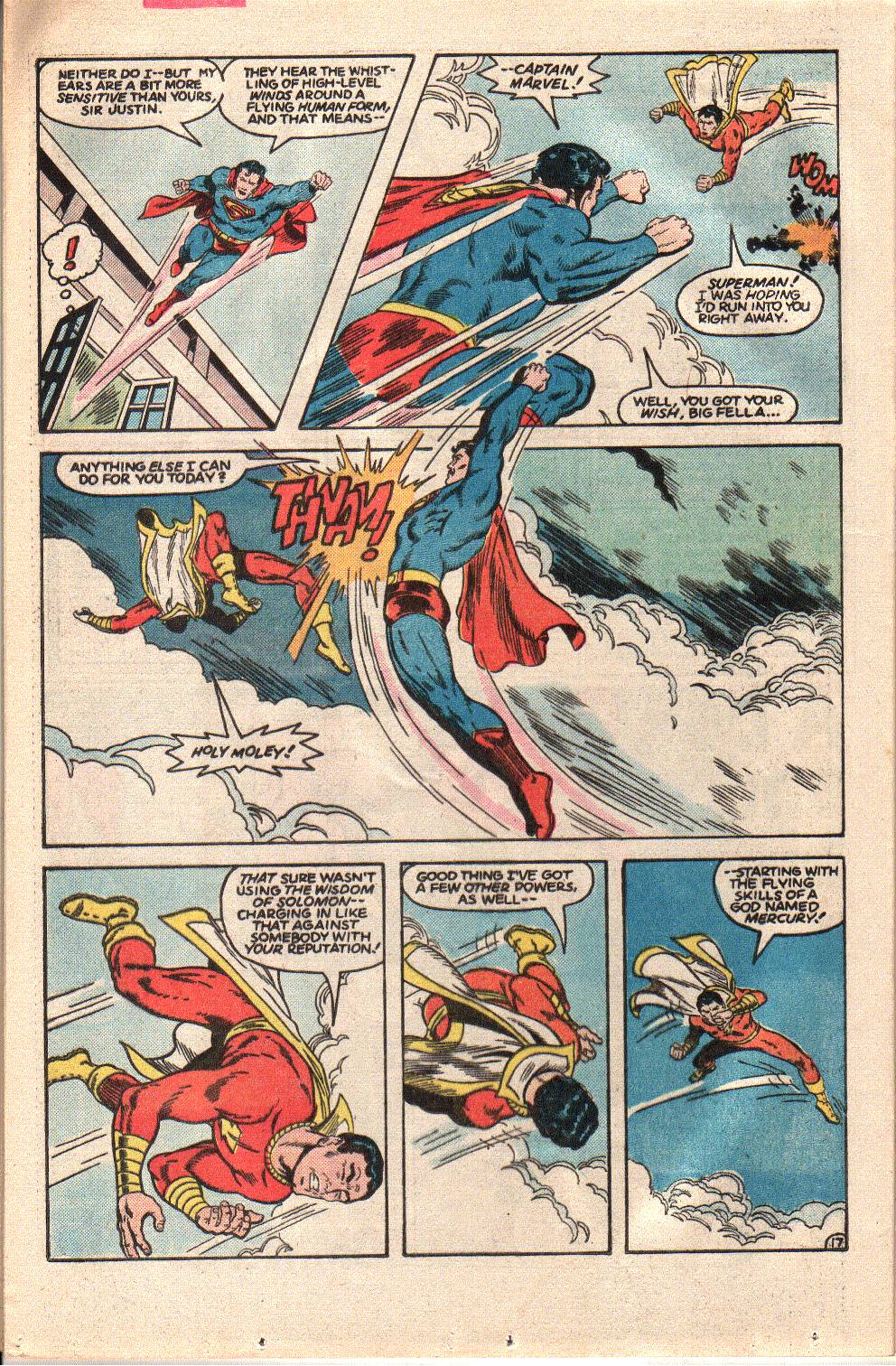 The battle is fierce and Superman burns him with his heat vision, but Hauptmann Wunder lays him out. Green Lantern grabs him with his ring; but, Wunder is able to slowly move through the energy. He punches GL, who reapplies the ring as a facefull of green fire, blinding Wunder. Hawkman joins the fight, followed by Batman and Wonder Woman, in her invisible plane. Hauptmann Wunder turns away and speeds across the Channel. The others follow until Batman realizes what he is trying to do and yells a halt and GL stops Hawkman in time. 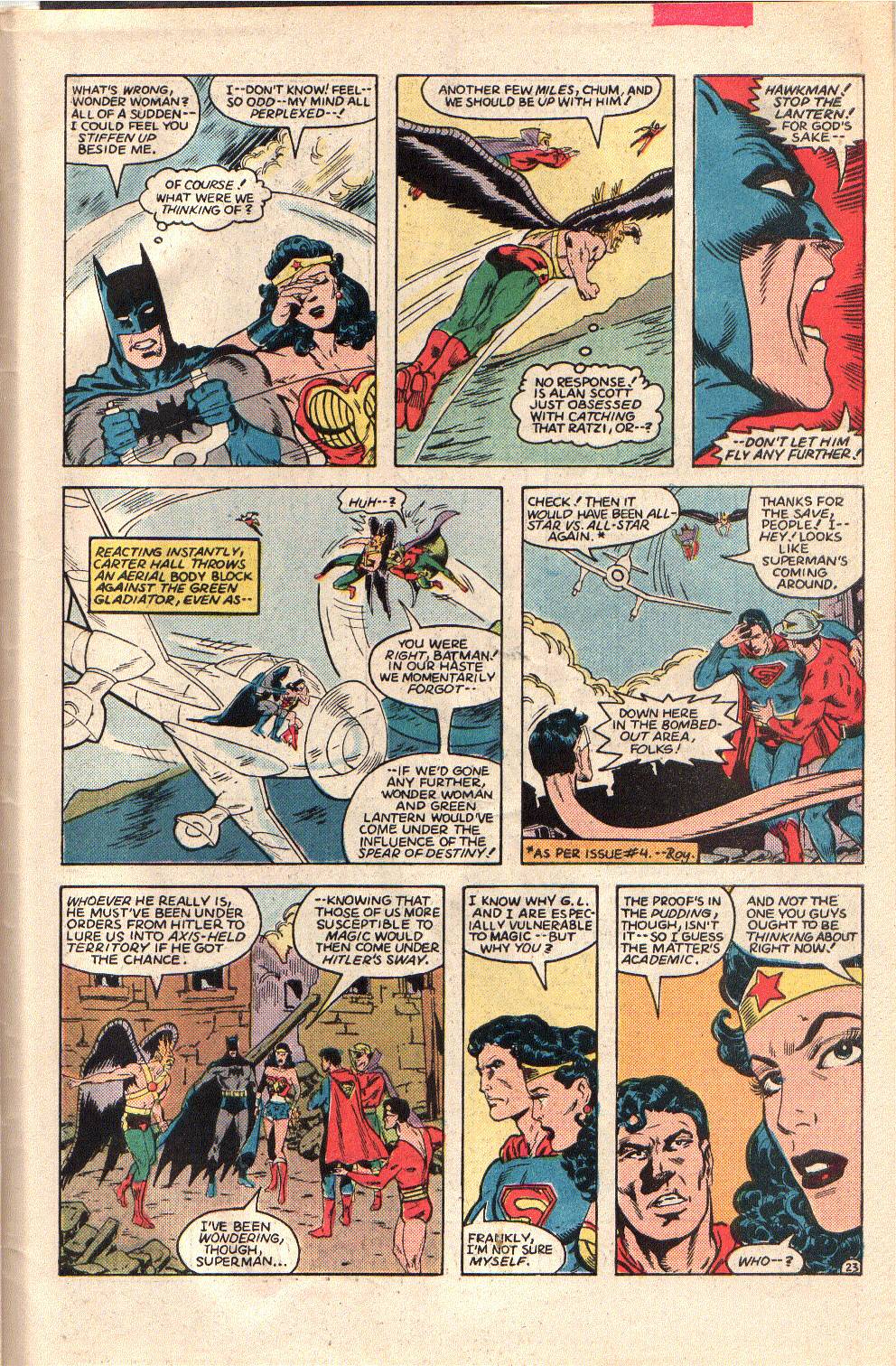 They regroup where Superman fell and confer, when they are interrupted by the two shadowy figures: Mary Batson and Freddy Freem; or, as they are better known, Mary Marvel and Captain Marvel Jr... 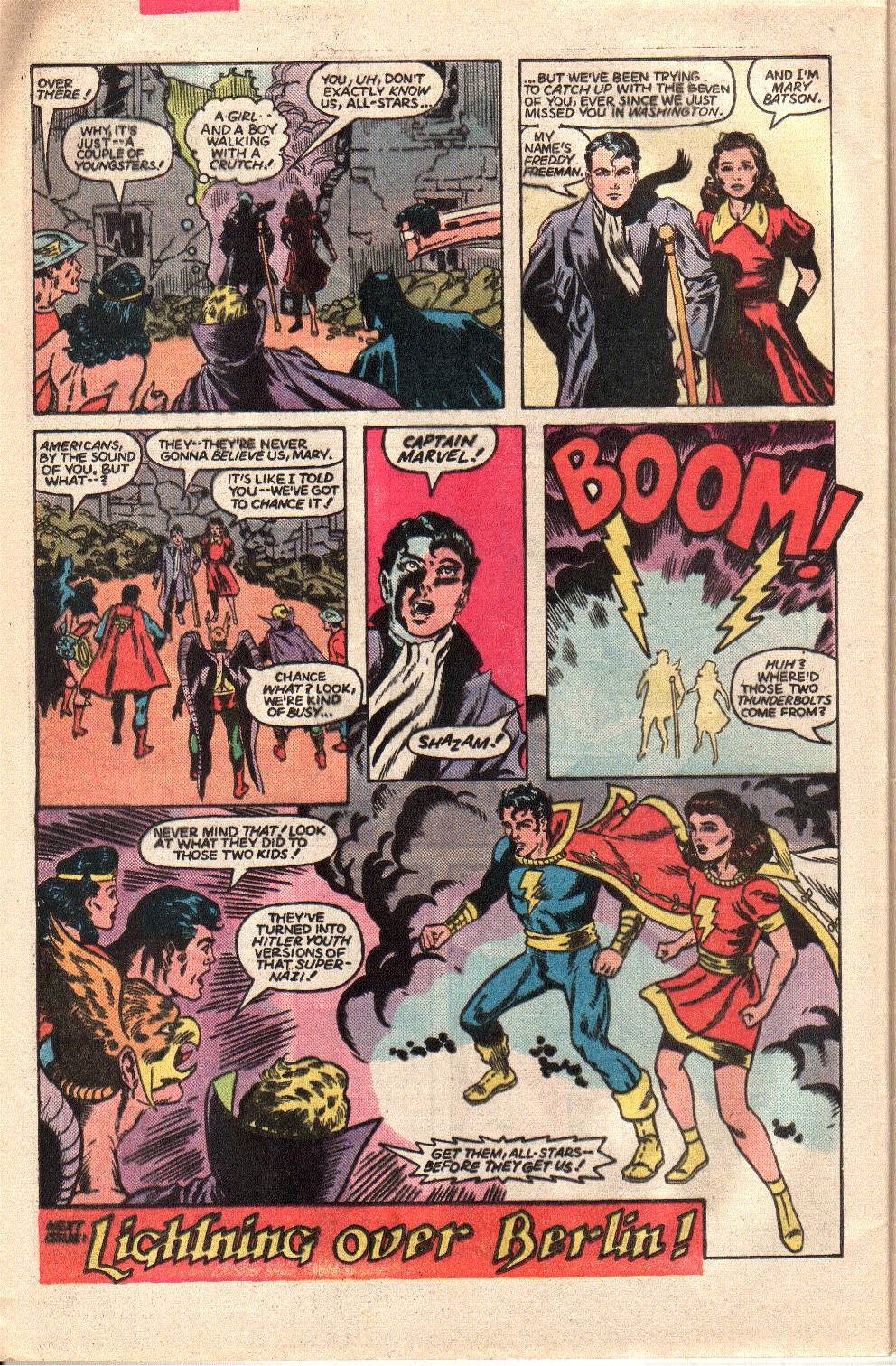 Thoughts: Thoughts: Excellent issue, as Roy sets up a major problem for the All-Stars, while also creating the mystery of how Captain Marvel came under the control of Adolf Hitler. How did he get to Earth-2, along with Junior and Mary? And where is Uncle Dudley? Are these the Earth-2 Marvels or are these the real World's Mightiest Family, of Earth-S? You're damn skippy I'm coming back next month, to find out! Roy is an unabashed fan of the Marvels and he turned Marvel's trademark hostage into a modified version, a sort of Blue & Red Cheese, for a time, when he turned Rick Jones into an ersatz Billy Batson, switching places with Captain Mar-Vell. Now, he gets to handle the real deal. And he handles him well. Buckler is another fan and he goes to town on this, just as he did in the Superman vs Shazam Collector's Edition (which gave Alex Ross the idea for Captain Marvel battering Superman with his magic lightning, with rapid changes between Captain Marvel and Billy Batson). This looks sensational and I still wish he had stayed on the book, as he is the best artist for the material, next to Da Ordster! Roy reminds us in the letters page that DC was then only licensing the Marvels from Fawcett, and only the Marvels, as a writer requests seeing Spy Smasher and other Fawcett heroes (as well as more Quality heroes and Spirit buddies, which were owned by Will Eisner). At first, DC licensed Captain Marvel, but added some of the other Fawcett heroes, with permission. However, there came a point where Fawcett was only licensing the Marvel Family. DC was somewhat limited in what they could do with them, for whatever reason. Eventually, DC would outright purchase the Marvel Family and characters, possibly all of the Fawcett heroes, though I have never seen that element confirmed. Jerry Ordway did use Bulletman, Spy Smasher and Minute Man in The Power of Shazam and Alex Ross had new versions, in Kingdom Come. Roy would get to do more with Captain Marvel, when he wrote the Shazam: The New Beginning mini-series, drawn by Tom Mandrake, where he created a new post-Crisis Captain Marvel, along with Black Adam and Dr Sivana. Unfortunately, aside from a story in Action Comics Weekly, that was it for The Big Red Cheese, until Ordway's Power of Shazam graphic novel. Well, Cap did get used in the Legends mini (which set up the Shazam mini) and in Justice League (also set up by Legends). This time, I think Roy has a better focus on the story that fans want to read, rather than playing continuity contractor and mixing in distracting subplots. Historical Notes: Roy brings in William Stephenson and mentions him being the liason between he and Churchill, even before the US entry into the war. Stephenson was Canadian and served with the Canadian Expeditionary Force, which was broken up among other regiments and he ultimately ended up attached to the Royal Flying Corps, when he was released from the Canadian military and signed into the Corps. He flew Sopwith Camels (alongside a funny looking kid, with a big nose) and had 12 kills to his name, before being shot down behind the lines and was taken prisoner by the Germans. He was released in Oct 1918. He returned to Canada and went into business, but was not successful. He went back to England and established successful businesses, including a patent for transmitting pictures via radio transmission, which earned him a fortune. he married an American tobacco heiress and diversified into several businesses. He was recruited by British intelligence and sent to the US to run the British Security Coordination, which was tasked in investigating enemy activity, protect British property from sabotage, and influence American public opinion to aid the British. A large segment of their efforts were geared towards bringing the US into the war, with the British, creating pro-British propaganda and letters to editors of newspapers and the like. Stephenson also acted as an advisor to FDR, on security matters. It was Stephenson who advised FDR to appoint Col. William J Donovan as the head of the newly formed Office of Strategic Services (OSS) which was to coordinate intelligence gathering for the US and would evolve into the post-war CIA. He was also one of the few trusted with raw ULTRA decodes and given authority to pass on what he deemed necessary to the US and other allies. He was not, however, a liason between Churchill and Roosevelt and Roy seems to be basing his information on the now-discredited book, A Man Called Intrepid, by William Stevenson (not different spelling, as it isn't the memoirs of the man, himself). Many claims maid in the book have been proven false or misleading and there is even question that Intrepid was his code name, with evidence that this was the telegraphic address for the BSC. Much of the scholarship that refuted Stevenson's narrative came after this comic was written; so, it's not Roy's fault. Years later, conservative revisionists who have tried to repaint FDR as colluding with Churchill to force the US into WW2 have played up the Stephenson angle. The reality is far more complex. FDR was certainly sympathetic to the British cause and could see that the US was likely to become embroiled with the war, at some point. He also was wary of German influence in Europe, both pre-war and its conquest, during. War with Japan had been brewing for some time and the idea that Roosevelt "allowed" the Pearl harbor attack to happen is ridiculous. War plans had foreseen the possibility of an attack on the US Pacific fleet at Pearl harbor, for the precise reason that it was home port to the fleet. It was the reason Hawaii was annexed int he first place (along with economic considerations). The very reason was that the Japanese did the same thing in 1904, against the Russian naval base at Port Arthur, in Manchuria, launching a surprise attack on their fleet. However, wartime intelligence suggested the greater threat was to US interests in the Philippines, rather than an attack on Pearl Harbor. The Navy believed that the shallower waters of Pearl Harbor made it invulnerable to torpedo attack, until the Japanese disproved this by training their pilots to make shallower torpedo runs. No, the Navy expected an attack on the Philippines, which is why the garrison there had been strengthened, before the war. It was a failure of intelligence, both the gathering of information and imagination to see how the unexpected could be accomplished. This kind of institutional thinking has plagued militaries and governments for centuries. What is true is that Roosevelt agreed with Churchill that stopping the Nazis was the greater priority and the Pacific Theater was woefully under-equipped to carry out their missions, for nearly 2 years. However, Japanese strategy had always been built around securing territories for raw materials and food, while establishing a system of fortified island bases to protect the Japanese sphere of influence. The attack on Pearl Harbor was not intended to conquer America; but to prevent it intervening on their planned attacks across the South and Central Pacific, to create that line of defense, while conquering the lands that could provide fuel and mineral resources. September 1942- Fighting continues on Guadalcanal, as the US controls part of the island, around the captured airfield, which has been renamed Henderson Field. On September 2, the Small Scale Raiding Force, aka No. 62 Commando, carried out Operation Dryad, and attack on the Channel island of Les Casquets, near Alderny. A lighthouse there was used as an observations point, as some of the fastest currents in the English Channel flowed past there, making it an ideal sailing area. The British deemed it ideal for a commando raid and had planned several previous ones that were cancelled, due to weather. The team traveled on a motor torpedo boat (known as The Little Pisser) and landed secretly, catching the garrison completely by surprise and capturing 7 prisoners without firing a shot. They eventually captured 19 prisoners, where mission planning had only accounted for 10. The men were taken back to England, after the commandos seized intelligence material, smashed the radio, and dumped the German weapons into the sea. The Germans were oblivious until they stopped receiving reports and sent a scouting party. They ended up re-garrisoning the lighthouse with a stronger force. The activities of the SSRF led to a later mission, where escaping German prisoners were shot, leading Hitler to issue the "Commando Order," which dictated that captured special raiding forces were to be treated as spies and executed. The orders were kept secret, given to senior commanders, though many, including Rommell, never disseminated the order to their subordinates. There were executions committed though and charges were brought at the war crimes trials. Gen Anton Dostler was sentenced to death for carrying out the order, with the court rejecting the legality of the order. It was used as part of the convictions of Generaloberst Alfred Jodl and Field Marshal Wilhem Keital, both of whom were hung. The Germans attempt to liquidate the Lachwa Ghetto, in Poland, leads to the first uprising in an occupied territory. Others would follow, including the mass Warsaw Uprising. Jews in Wolbrom, Poland, were rounded up by Germans and Ukranians and completely wiped out. A memorandum issued by August Frank gives specifications for the disposition of confiscated property from "evacuated" (murdered) personnel. Money was confiscated by the state and paid into an SS Reichsbank account. Watches and similar possessions were repruposed for sale at post exchanges, for frontline troops. Clothing and household goods, especially fine fabrics and furnishings, were turned over to the Volksdeutche Mittlestelle, for redisposition to ethnic German populaces, outside of Germany. women's silk underwear and furs were highly prized. The Japanese submarine, I-25 surfaced off the Oregon coast and launched a floatplane to drop two incendiary bombs on forrested areas, to create a wildfire. However, the bombs were not dropped at the correct height and forestry service personnel were able to contain it.  (The float plane hanger is the elongated bubble, forward of the coning tower, and the launch rail extends up towards the bow) A second bombing was attempted with negligible damage. Both the Womens Auxiliary Flying Squadron and the Womens Flying Training Detachment were established. These groups were merged, in 1943, to form the Women Airforce Service Pilots (WASPs), who ferried airccraft to military posts, towed targets for gunnery practice, transported cargo, and simulated strafing missions for training purposes. The group were civilian women pilots and were not given military status. Still, 38 women lost their lives in flying missions and one was missing, presumed dead. They were not granted veteran status until 1977, denying them both the recognition and benefits due to them for their service, which allowed male pilots to go to combat postings. I first learned about the pilots while touring Wright-Patterson Air Museum, which had a display dedicated to the women of the WASPs. To the best of my knowledge, Marvel never linked Janet Van Dyne to the real WASPs, even as inspiration for her name. Someone needs to get on that. SOE agents Andree Borrell and Lise de Baissac became the first female agents parachuted into occupied France, to coordinate Restance activity. Borrell had been a nurse and served with the Red Cross, and had worked with British-coordinated Resistance operations, before being evacuated to England. She attempted to join the Free French, but they were only interested in information about her activities for the british, which she refused to divulge. She was recruited by the SOE, trained, and sent in to the Paris area, as part of the Prosper Cell, operating there. She became second in command of the group and was well regarded. She was betrayed and captured in a Gestapo raid, in 1943 and remained silent against interrogation. She was eventually removed to Germany and executed, in 1944.  Lise de Baissac was a British citizen, from a French family, on the island of Maritius. Her family relocated to Paris, in 1919. She fled to England after the Germans overran France and was recruited by the SOE. She was tasked with creating a new resistance cell. There job was to be a link to other cells, coordinating supply drops and sharing intelligence, in a secure area. She used the cover of amateur archeologist to scout potential drop zones in the countryside. After the Prosper network was blown (and Borrell captured) she was evacuated back to England and assisted in training other agents. and suffered a leg injury. When it healed, she was sent back into France to coordinate the Pimento network. She was reunited with her brother, who had joined the British Army, in France, before the French surrender, who was parachuted in to scout potential drop zones in Normandy. After D-Day, she collected information to pass to the advancing armies. When U forces arrived to liberate her area, she appeared in her First Aid Nursing Yeomanry uniform, which she had hidden away.  The exploits of these and other women were dramatized in the tv series Wish Me Luck, about SOE operations in France, and the film Les Femmes de l'ombre, aka Female Agents, with Sophie Marceau and Volker Bruch (star of Babylon Berlin).   The Japanese launched an attack on the Allied airfield at Milne Bay, on eastern New Guinea, as the result of poor intelligence as to the garrison's strength. The Japanese landed 12,500 troops of the Special Naval Landing Force (the Japanese "marines"), in the belief that the garrison had only between 300 and 600 men. However, the Allies had received ULTRA signals that indicated the Japanese targeting the airfield and had reinforced it heavily. The Japanese sent their force from Rabaul and coast watchers alerted the Allies, who sent bombers to scout for the raiding force. Bad weather hindered efforts, but, a portion that had stopped at Goodenough Island were spotted by Australian Kittyhawk planes and the landing barges strafed and destroyed, stranding about 300 men on the island. The main body was spotted, but weather again hindered the attacks and little damage was done. Australian forces were redeployed on the area to strengthen their line of defense. The Japanese landed and moved inland, with the support of 2 light tanks, but no air cover, as the Allies had shot down aircraft sent from Buna and aircraft from Rabaul were turned back due to weather. The Allies strafed supplies and landing barges, eliminating their use to outflank the Australians, after the initial landings. The japanese mete stiff resistance from the 61st Infantry Battalion, who fought a retreat, before being replaced by veteran Second Australian Imperial Forces, who held positions. The Japanese landed reinforcements, but were harrassed by shelling. The Australians counter-attacked. The Japanese planned to reinforce, but were unable to do so and remaining troops were withdrawn. The Australians brought in aircraft and maintained anti-shipping air patrols, allowing them to maintain the area. The troops on Goodenough Island remained stranded until October. The battle resulted in the first decisive defeat of the Japanese on land and did much to boost Allied morale in Burma and along the Kokoda Track, on New Guinea, where fighting with the Japanese was ongoing. Here, and in fighting on Guadalcanal, the Japanese were increasingly being shown to be vulnerable and and end was coming to the myth of them being invincible fighters. However, as Guadalcanal would show, they would fight to the death, rather than surrender, if withdrawal was not possible. Victories over the Japanese would come, but the costs would be very high. In the Atlantic, u-boats sink 6 ships in North Atlantic convoy ON-127 and German cruiser Stier and US Liberty Ship SS Stephen Hopkins engaged in a gun battle that ended in the sinking of both ships. It marked the first time a German vessel was sunk by an armed merchant ship. She had one 4 inch gun and 2 37 mm anti-aircraft guns, plus 6 machine guns. 
|
|
|
|
Post by mikelmidnight on Aug 31, 2020 11:33:19 GMT -5
  Dr Doog (fought Starman, in his debut), Catwoman, Sieur Satan (fought the Flash), Alexander the Great (fought Hawkman on his 2nd mission), Lightning Master (fought Superman in Supes #14), Tarantula (fought Sandman in his debut, not John Law), Wotan, Zor (fought the Spectre). I appreciated the historical accuracy of this grouping (having found the time traveling villains in the first arc overly convoluted), although the visual blandness of the team made me appreciate Roy's dilemma a bit more. |
|
|
|
Post by codystarbuck on Aug 31, 2020 21:21:54 GMT -5
One of the weaknesses of so many Golden Age comics was the lack of memorable villains. That was part of what made the Dick Tracy comic strip memorable and Bill Finger swiped the idea for Batman. Dc did a better job than most companies, though it took a while, for some characters. The Marvel Family had a pretty diverse bunch, which helped to fuel the epic serial The Monster Society of Evil. For many characters, the best they managed was one enemy. Crimebuster fought Iron Jaw, though he was scary enough that you could do a lot with him (and they did, enough for an entire book of reprint stories, from AC Comics). The MLJ heroes never really developed any, apart from The Skull, who was part of the Black Hood's origin and who fought him several times. Quality Comics were a bit lacking, in that department. So was Timely. Captain America had the Red Skull and that was pretty much the only major baddie, of any real stature.
You get a lot of murderers in hooded robes and fright masks, mad scientists, dictators, gangsters and petty thugs; but, not as many A-list villains.
|
|
|
|
Post by codystarbuck on Sept 4, 2020 21:09:30 GMT -5
All-Star Squadron #37 Creative Team: Creative Team: Roy Thomas-writer/editor/Grand Poobah of Earth-2, Arvell Jones-pencils, Richard Howell-inks, Lois Buhalis & Tom Orzechowski-letters, Gene D'Angelo-colors Synopsis: When we last saw the All-Stars, they had been hailed by Freddy freeman and Mary Batson, who had transformed into Captain Marvel Jr and Mary Marvel. This being a comic written by a former Marvel writer, they are about to be attacked by the All-Stars, in a misunderstanding 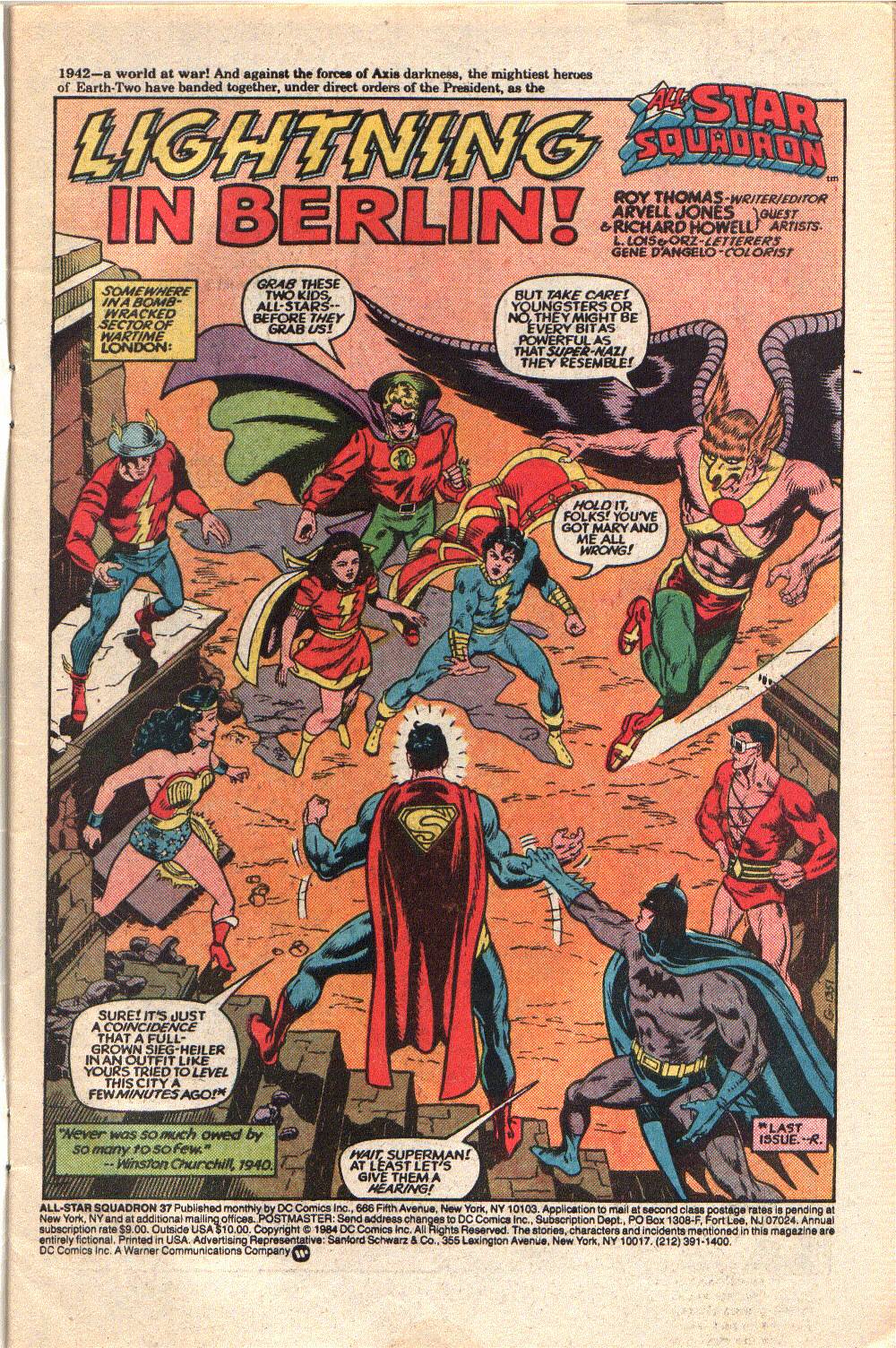 Superman acts like a jerk (probably because Roy is on the Big Red Cheese's side) and Mary and Junior take him for a ride, until Wonder Woman and Green Lantern get involved. However, Wonder Woman and Batman tell off Superman and he stops acting like Super Richard. Mary then tries to explain. They were flying along (on Moonlight bay) and Captain marvel was struck by magic lightning and disappeared. The other two went and consulted the wizard, Shazam (see kids, he's the wizard, not the dude in the red longjohns) who said he was pulled to a parallel world. 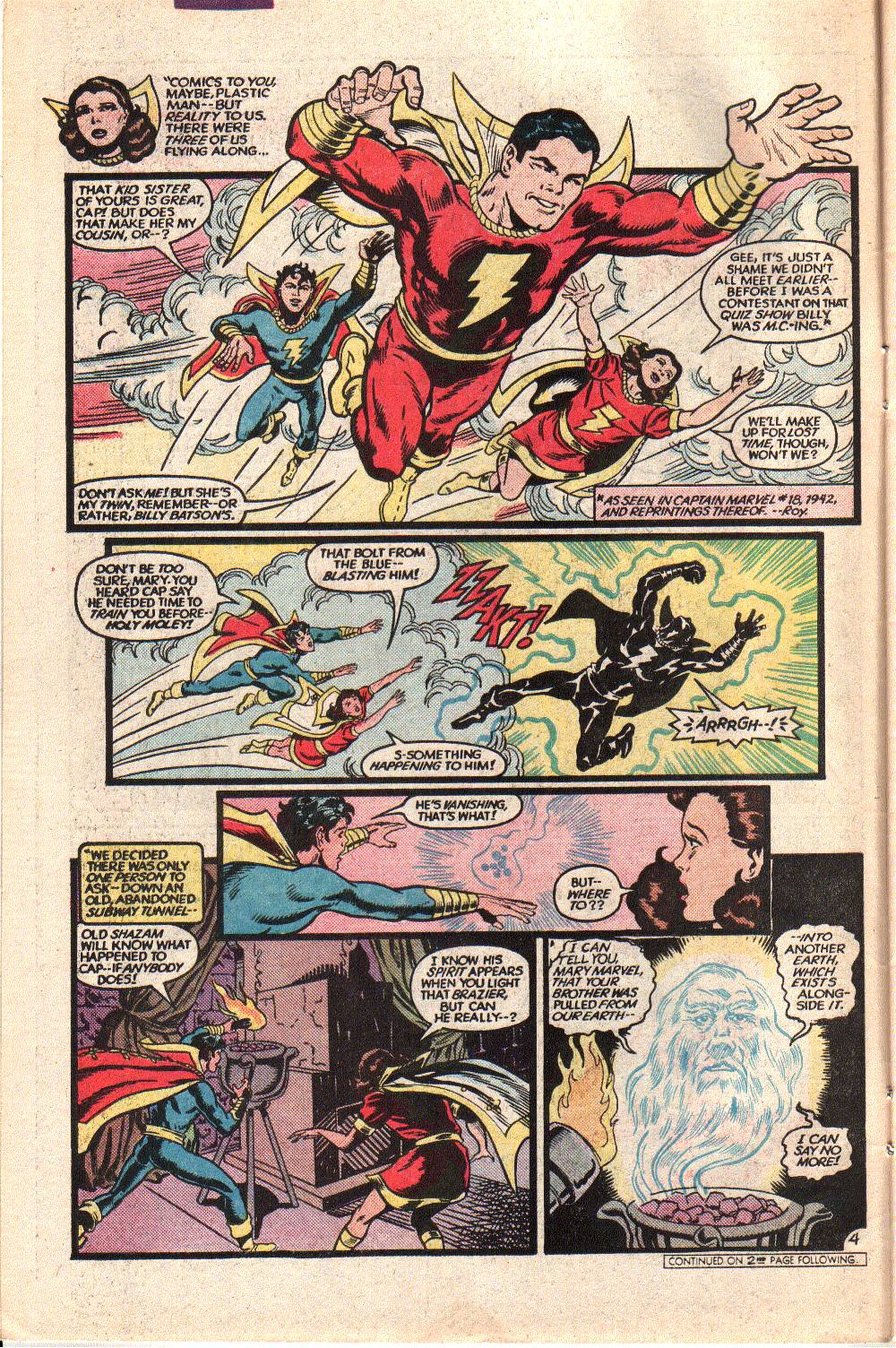 The Marvels just magicked themselves there, with Shazam Powers (I must have missed that issue of Whiz or Captain Marvel Adventures) and the rest is history. They decide to put their heads together and Wonder Woman leads everyone to her invisible plane, so Roy can insert a lame joke... 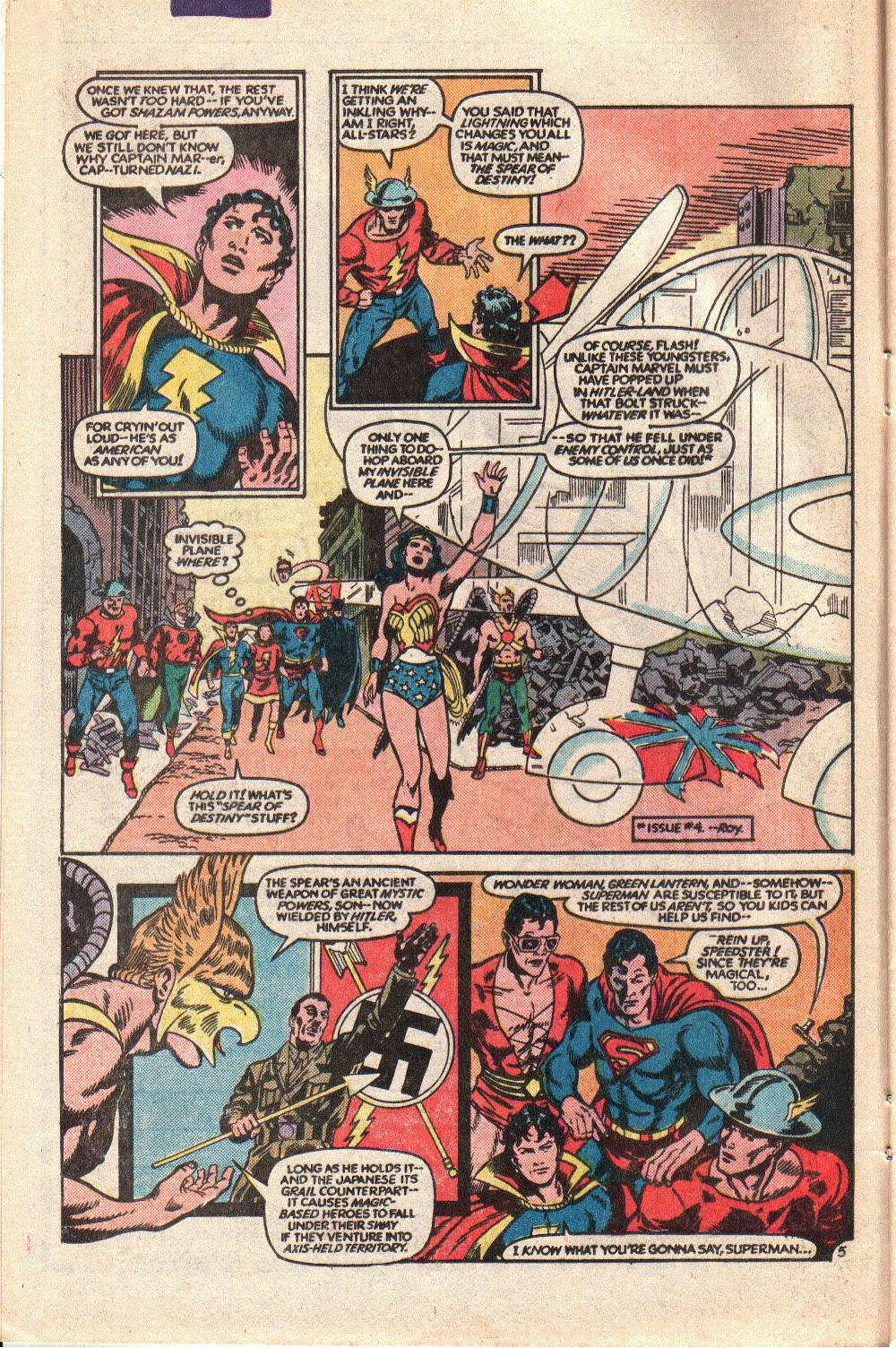 Mary and Junior realize that their other selves aren't magic-based and switch to them to follow along with Plas, Flash and Batman, as Roy illustrates that he doesn't know a dirigible from a blimp.... 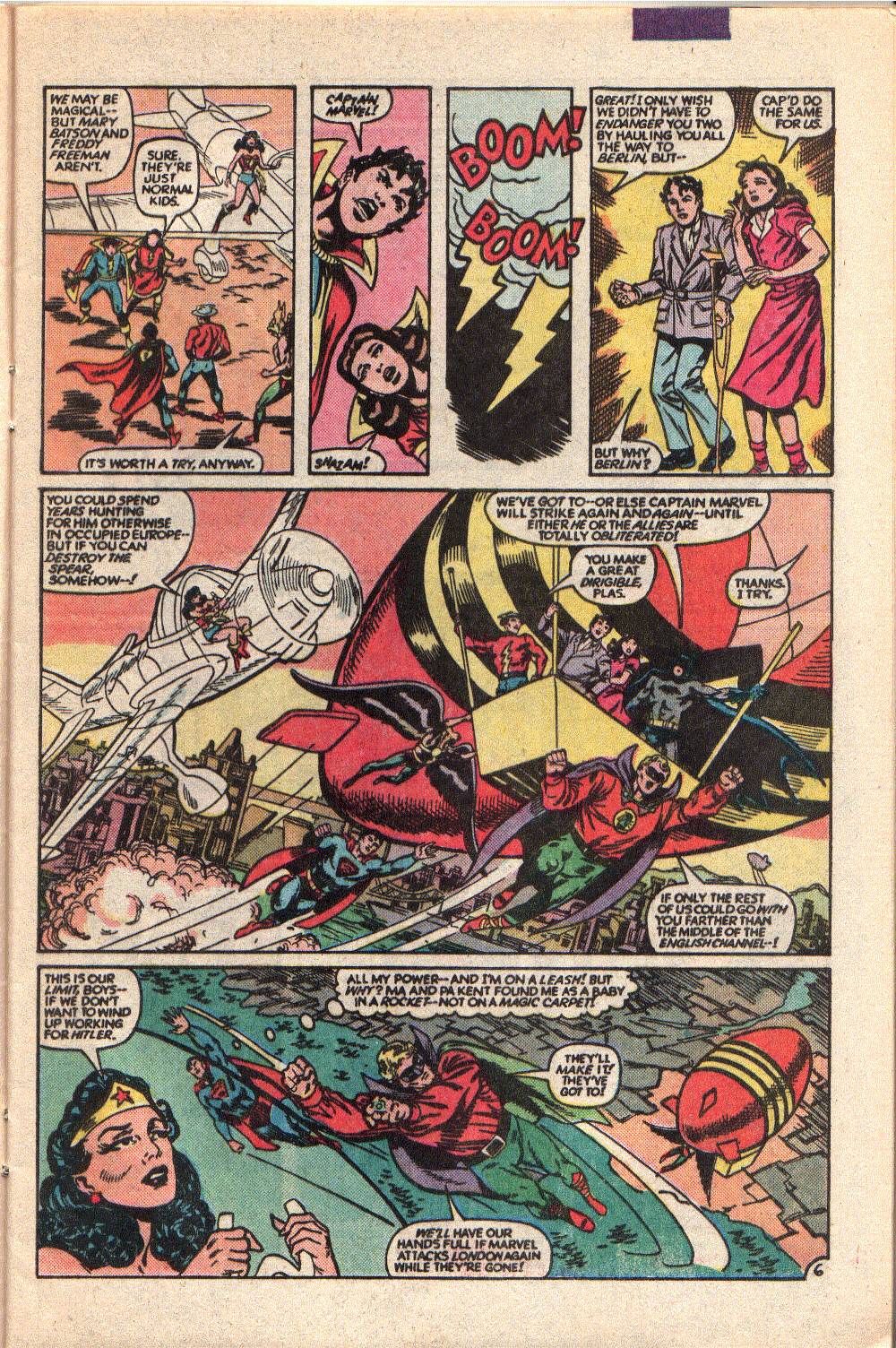 You see, Roy, a dirigible has a rigid internal support structure, with gas cells to provide lift. A blimp is an envelope of lifting gas, with a control car attached below the envelope. What Plas creates is a blimp.....a BLIMP. The really powerful ones escort them as far as they can, then turn back (so, would that be the Channel Islands, the Three Mile Limit or the halfway point of the future Channel Tunnel?) They cross over France, then into Germany and Berlin and come up on the Reichschancellory Building and enter through a window (probably at the balcony that Speer added). Batman is still cool with a couple of kids, one on crutches, walking deep in the heart of Nazi Country. They sneak up on some Nazis telling Italian jokes and bop 'em on the head, then find the super-gagged Billy Batson and free him... 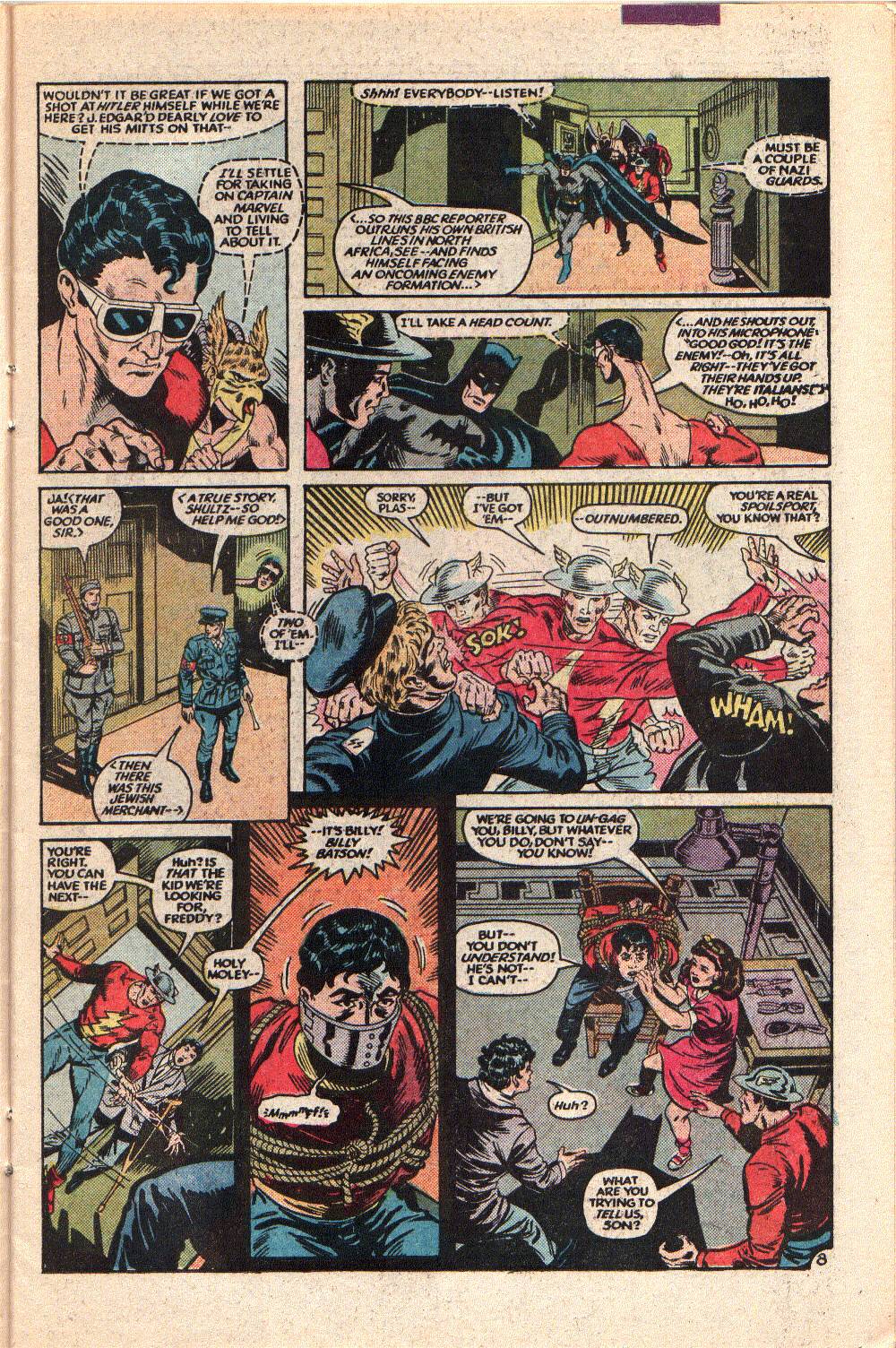 Then Captain marvel bursts in, with Adolf and tells everyone that Billy Batson isn't Captain Marvel. Billy explains... 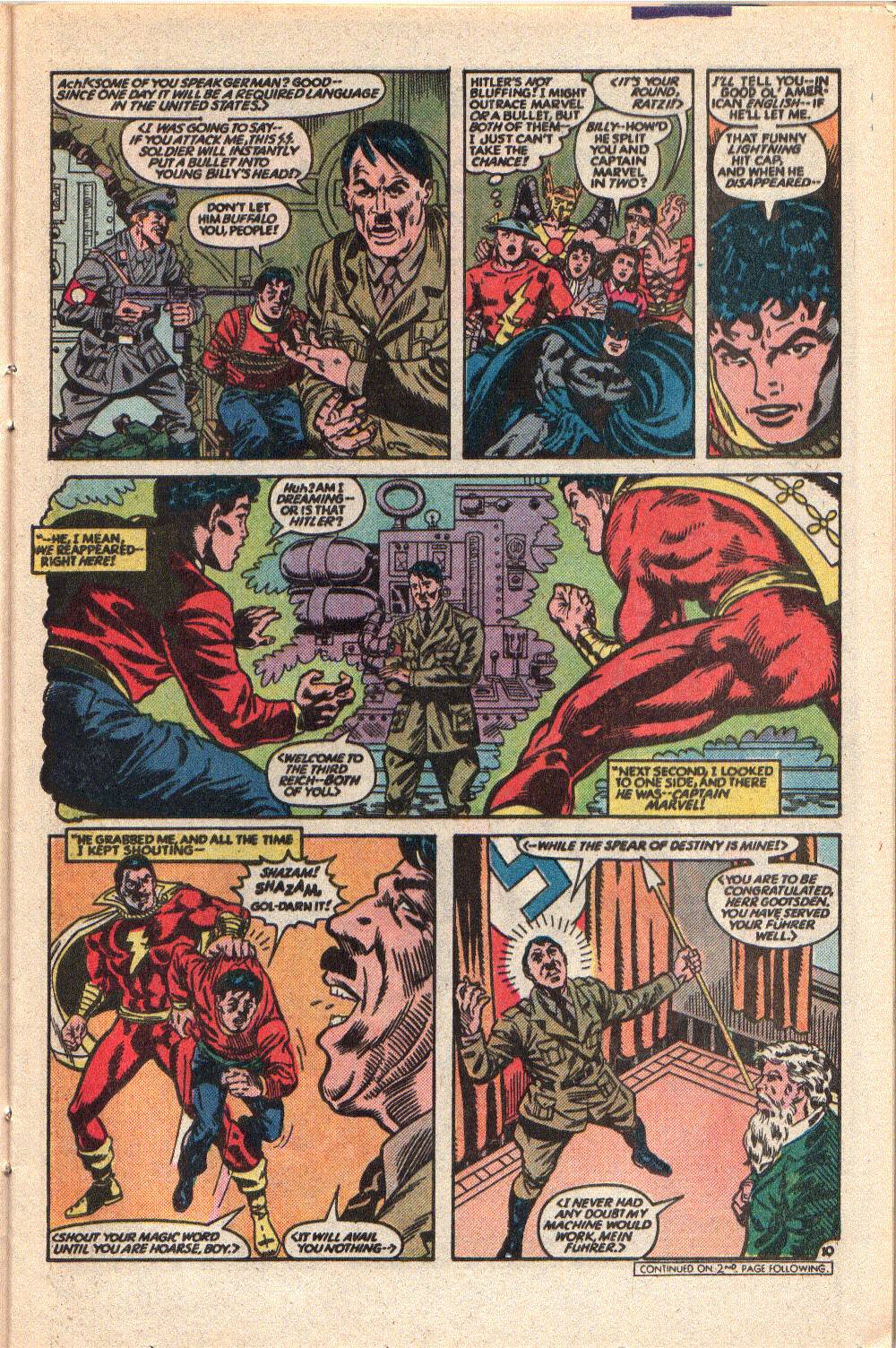 Engineer Gootsden is responsible, as his machine split Cap & Billy and now he does it to Freddy & Mary, and Junior and Marvel appear and fall under the spell of the Spear of Destiny. They lift a V-2 rocket to deliver to London... 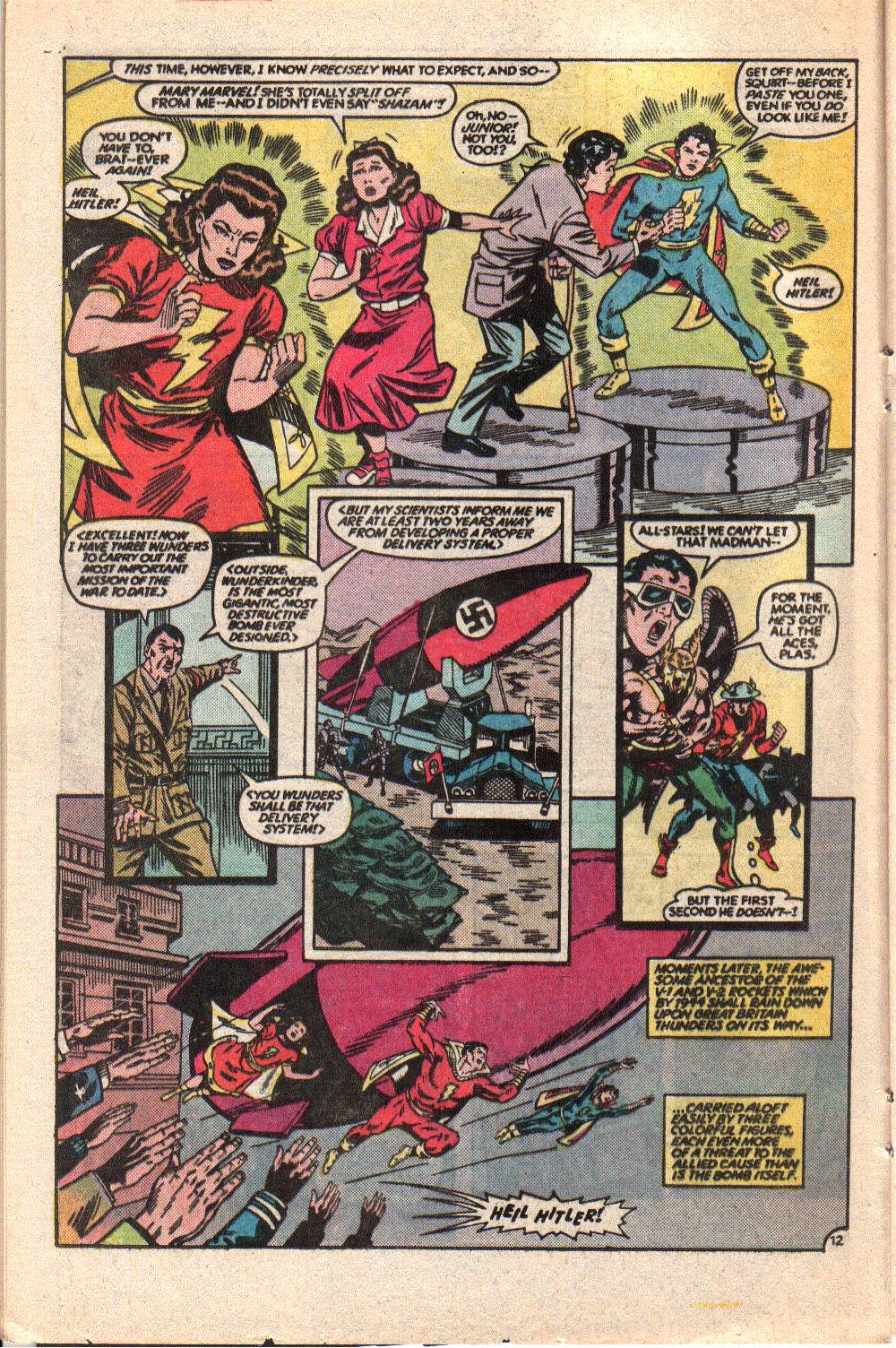 Billy distracts a Ratzi and Flash jumps to work, soon joined by Hawkman and Batman, as the kick Nazi Heine! they scoop up the kids and dump them on Plastic Blimp and sail away. Hitler orders that they not reach London. Meanwhile Superman is stewing for a fight. The marvels show up and he, GL and WW head to intercept. Hauptmann Wunder hurls the V-2 at Westminster and the trio break off the fight and stop it. The Marvels attack again. Meanwhile, Plastic Blimp is shelled by anti-aircraft guns, near Dover and hits the drink, but turns into a raft to save everyone. Some German E-Boats just happen to turn up and attack them. It looks like their geese are cooked, until the cavalry arrives... 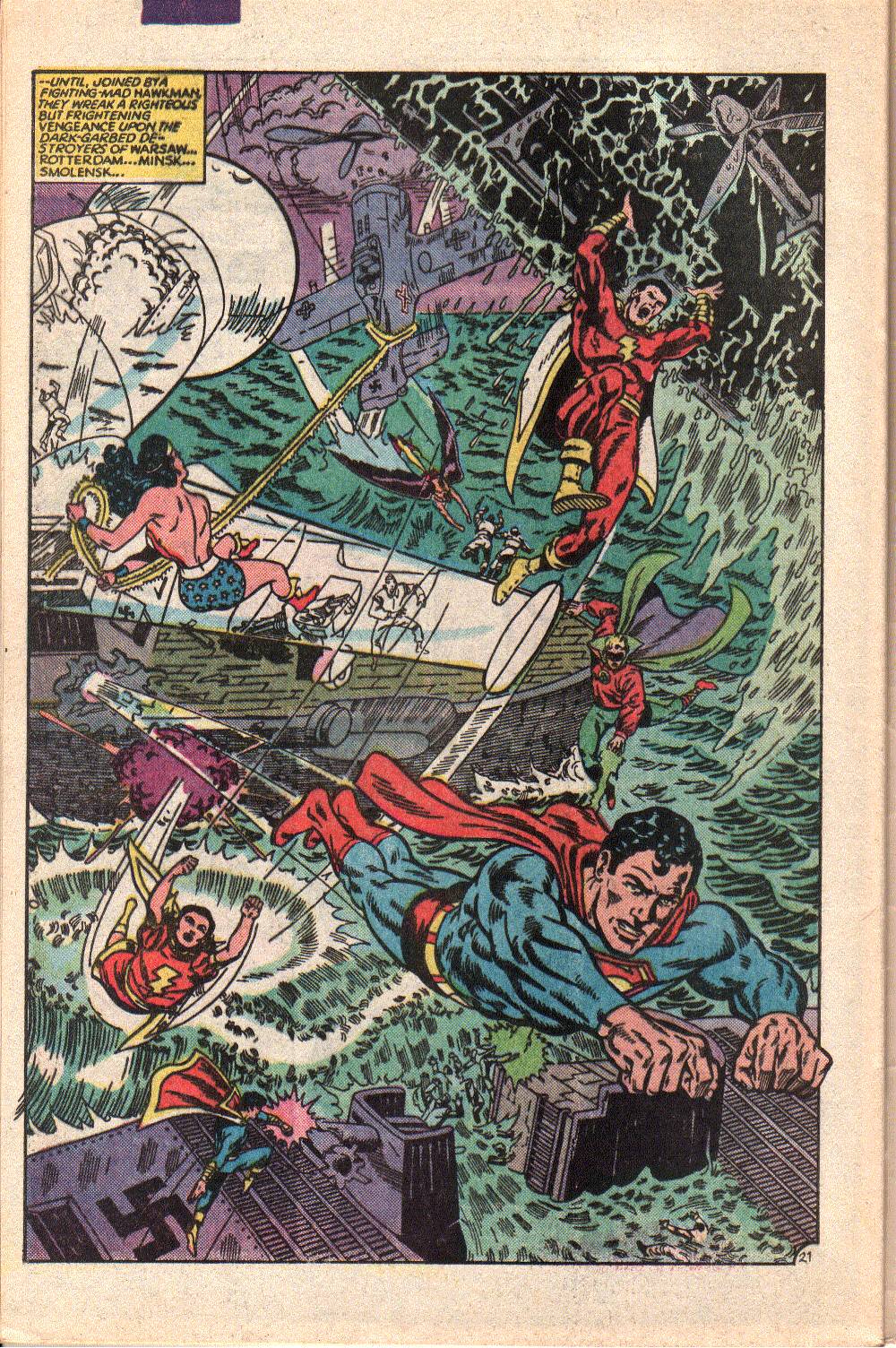 The Marvel kids are far enough away to release the hold over the adult Marvels and they want some goosestepping backsides as payment. After whooping Fritz, Billy hits on the idea for all 6 to say their magic words and they flash back to Earth-S. Thoughts: This started out pretty well, with a cool little mystery; but, the conclusion feels a bit more juvenile than the set up did. Way too many magical solutions, for my tastes, like Roy wrote himself into a corner, or something. I'd have to go back and re-read some stuff; but my foggy memory is that it took the Rock of Eternity to move the Marvels beyond their universe. Might be mis-rembering that, as I seem to recall the JLA/JSA/Fawcett crossover was all on Earth-S. So was their part in Crisis. Arvell Jones joins as new regular penciller. and he is a bit rough around the edges and struggles with the kids, particularly at certain angles. It's a big change from most of the previous artists, who tended towards a cleaner line. The combination of Jones & Howell makes it look a bit more like a fanzine story, or maybe an Underground. Roy perpetuates some bad stereotypes, particularly Hitler talking like a cartoon villain (okay, it's a comic book; but, still...). Strip away propaganda and most accounts of people who met Hitler said he was a charismatic figure, in person and wasn't always screeching or orating, like at Nuremburg. Reducing him to a cartoon belies the fact that he was hardly unique in the world of his time or others. We have just as dangerous people today, with feverish supporters. The second stereotype is that the Italians were poor soldiers. This is total BS. The Italians were major elements of Rommell's forces and fought as hard as the Afrika Korps.. The problem was their government and senior leadership, as well as outdated equipment and armaments. By the time the Allies invaded Sicily, the Italians had had enough of Mussolini, leading to his arrest and their surrender, which led the Germans to occupy much of the country, to stall the Allied advance towards Germany. The next issue blurb previews the return of Amazing Man and a pseudo-Klansman. Get ready for one of the darker sides of the so-called Greatest Generation, as we look at racial unrest during the war, in metaphor. Historical Notes: Hitler mentions that the bomb, which is a V-2 rocket, doesn't yet have a propulsion system. That is not entirely true. In October, the Germmans test-launched the first A-4, which would become the V-2, as a military weapon, at their facility at Peenemunde It flew over 147 km and reached a height of 84.5 km. Two years later, the Germans would launch the rockets at London, Antwerp and Liege, rsulting in over 9,000 civilian deaths, plus an additional 12,000 deaths of slave laborers forced to work on construction of launch sites and other related facilities. Captured weapons would form the basis of both US and USSR ballistic missile development. Oct 1942 At theaters, the Terrytoons cartoon, The Mouse of Tomorrow premiered, debuting a new character, Super Mouse, who would be renamed and become famous, as Mighty Mouse. The International Red Cross held a special session in Geneva, but refused to issue a condemnation of the holding of civilians in concentration camps. The Germans built special show camps, like Theresienstadt, where Red Cross observers were spoon fed false images of happy communities and reported such internationally, leading the Jewish and other ethnic prisoners to feel abandoned. Many prominent Jews were quartered at Theresienstadt, including some noted artists, such as Bedrich Fritta, Norbert Troller and Petr Kien. They were tapped to create propaganda for the SS; but secretly recorded the reality of the camp. They smuggled some of it out, but were discoverd and tortured, though more art was discovered later, providing a record of the elites vs the mass life in the camp. This was used as a story element in the mini-series Holocaust, which follows the Weiss family, a group of German Jews, from Kristallnacht to the end of the war. James Woods played Karl Weiss, a young artist who is imprisoned early on, at Buchenwald, then moved to Theresienstadt, after his Christian wife, Inga, persuades a Nazi (a friend of her family) to get Karl better treatment, leading him to be sent to the show camp. he and the artists there produce the secret drawings, which are uncovered and his hands are broken and he is shipped off to a work camp, where he will die. Towards the end, he takes a piece of charcoal and sketches the horrors of the camp, which are used to confront the main Nazi character, Erik Dorf, who goes from unemployed patient of Dr Weiss to an SS officer, working under Heydrich on the Final Solution. He is captured at the end of the war and confronted with Weiss' drawings. I found the mini-series to be gripping and enlightening, very well acted, but it wasn't without criticism. Elie Weisel dismissed it as "Untrue, offensive, cheap ..." Others felt it trivialized the Holocaust, especially as NBC ran commercials, which earned revenue. Clive James, writing for the Observer, took a different opinion, praising how Michael Moriarty, as Dorf, got into the minds of the Nazis, to display their jealousy of the Jewish intellectual and professional classes of Germany and how the Jewish community failed to understand how they, who were Germans, were so hated by their own country men. It is fiction, but so is the novel that formed the basis for the film Schindler's List. Both are inspired by real people and events. I can see the criticism of running commercial advertising during the broadcast, as it does cheapen things; but, I do think the series was a thoughtful portrayal. There was also criticism from Polish communities about the depiction of Polish soldiers, who supervised trains with prisoners. This has long been an area of contention in US Polish communities, with some trying to minimize factual accounts of Polish collaborators and others trying to highlight Polish victims and resistors. The same story played out in much of Occupied Europe, as human beings sought survival by conforming, joining or resisting. It would fuel politics and social life in those lands for the decades that followed the war. Meanwhile, in the United Kingdom, at the end of October, a meeting of religious leaders and politicians voiced outrage at the treatment of Jews in occupied territories, illustrating that it wasn't as much of a secret as the governments would try to paint it. Also at the end of the month, the Second battle of El Alamein began, extending into early November, as the new head of the British 8th Army, Bernard Montgomery, had been building his forces, while a state of equilibrium had been in force. The Germans had severe logistics problems, as ULTRA intercepts identified ship movements to North Africa, allowing them to be targeted. while Rommel's supply lines stretched back to Tripoli, A failed attack, led the Germans to go into a defensive arrangement, before Rommel left the theater to return to Germany for medical treatment. Montgomery went on the offensive, with British and Commonwealth troops making fierce attacks, following massive bombardments. They had to clear minefields to allow armored units to pass through and attack German positions, which slowed the advance in some areas; but, the British had made great strides in coordination their intelligence activities and had a very good picture of the German disposition of forces, logistics issues and also had a superiority in the air. The British had also found some aggressive generals, such as Brian Horrocks, who led XIII Corps and was considered by most to be one of the best fighting generals of the British Army. The British found stiff resistance in the early stages, especially from the 185th Airborne Division Folgore, those Italians that Roy mocked via a German guard's jokes. They inflicted 300 casualties in he initial attack and fought like lions throughout the battles. In the end, the British had superiority in numbers, tanks, artillery pieces, and air support, as newly arrived Spitfires supported advances in coordinated attacks, while Axis air elements focused more on air-to-air combat. Ultimately, Rommel's forces had exhausted their supplies and couldn't match the British & Commonwealth numbers and attrition finally forced them into retreat. However, Montgomery's forces failed to take advantage of the final breakdown of Rommel's lines, as air elements did not pursue the fleeing Axis troops and they failed to cut off Rommel's fighting retreat at Mera Metruh and Fuka. Air forces believed that the Luftwaffe was due to be reinforced and acted cautiously in pursuit. Montgomery paused his advance to regroup and build back his forces, allowing Rommel to continue to place obstacles in their path, allowing them to retreat to Tunisia. However, the battle marked the end of defensive actions in North Africa and the beginning of offensive operations, which were to gain a very large boost, in November. In the Pacific, fighting continued on and around Guadalcanal. Japanese naval forces attempted to bring reinforcements to the island and ran into a convoy of Allied ships, leading to the Battle of Cape Esperance, where a mostly inconclusive engagement led to Japanese losses of two ships and one American, while the landing of supplies was successful. however, aircraft from Henderson Field, the captured airfield in Allied hands, sank another destroyer. Later in the month, the Battle of the Santa Cruz Islands occurred, as the Japanese again sought a decisive blow to the American carrier force. Adm Nogumo led Japanese forces, and had 3 fleet carriers and one light carrier, to the US fleet's 2 fleet carriers (Hornet and Enterprise). The end result was a tactical victory for the Japanese, as they succeeded in sinking the Hornet and heavily damaged the Enterprise, with Saratoga having been damaged in August. Enterprise was the only fleet carrier in the Pacific, but it was heavily damaged. However, the US aircraft inflicted heavy damage on the Zuiho and Shokako and heavy loss of aircraft. Zuikaku recovered aircraft from the other two ships and was withdrawn to Truk and Adm Nogumo was relieved and reassigned. The biggest loss was to the Japanese air arm. The US lost 175 planes, but only 26 pilots, as others were rescued. The Japanese lost 99 planes and 148 pilots and crew. US naval aviation was trained to operate from any carrier, allowing squadrons to be reassigned between carriers and continue operating. Japanese doctrine was to maintain the same air team on an individual carrier. Japanese losses resulted in a great drain on experienced pilots. This was largely due to their aircraft design and tactics, as the much feared Zero sacrificed armor for speed, which meant that a hit on one was more likely to be fatal than a similar hit on an American plane. Wildcats, the later Hellcats and the Dauntless dive bombers were built to absorb punishment and the Hellcats had a power plant that gave greater speed than the Zero. By this point, US pilots had developed tactics to neutralize the Zero's speed advantage and the war of attrition was working against the Japanese. On Guadalcanal, the Japanese launched an offensive to retake Henderson Field. The Marines were spread along a defensive line, at the perimeter of Henderson field. The Japanese launched several attacks along the perimeter, in hopes of breaking through the line and pouring into the rear and wreaking havoc. However, at a very high cost in life, the attacks were repulsed. The Japanese did not surrender and would hurl themselves in banzai charges and deadly hand-to-hand combat. One of these attacks consisted of 3,000 troops of the Sendai Division, which attacked a sector manned by 2 heavy machine gun sections, led by Marine Sgt John Basilone. Basilone and his men were cut off but maintained fighting for two days, inflicting heavy casualties with their water-cooled .30 cal machine guns. Running low on ammunition, Basilone fought his way through the enemy to secure more ammo belts and brought them back, allowing the Marines to keep up their rate of fire. He repaired one machine gun under fire, getting it back into action and deployed another with his own hands, despite the loss of an insulating glove, resulting in severe burns to his hands from the hot barrel. He continued to lay down effective machine gun fire and fought the Japanese with his sidearm and a machete, when ammunition ran out. By dawn of the second day, the Japanese were wiped out to a man and Basilone and two other Marines in his section were left alive. Basilone received the Medal of Honor for his actions, with the following citation: "For extraordinary heroism and conspicuous gallantry in action against enemy Japanese forces, above and beyond the call of duty, while serving with the 1st Battalion, 7th Marines, 1st Marine Division in the Lunga Area, Guadalcanal, Solomon Islands, on 24 and 25 October 1942. While the enemy was hammering at the Marines' defensive positions, Sgt. BASILONE, in charge of 2 sections of heavy machine guns, fought valiantly to check the savage and determined assault. In a fierce frontal attack with the Japanese blasting his guns with grenades and mortar fire, one of Sgt. BASILONE'S sections, with its gun crews, was put out of action, leaving only 2 men able to carry on. Moving an extra gun into position, he placed it in action, then, under continual fire, repaired another and personally manned it, gallantly holding his line until replacements arrived. A little later, with ammunition critically low and the supply lines cut off, Sgt. BASILONE, at great risk of his life and in the face of continued enemy attack, battled his way through hostile lines with urgently needed shells for his gunners, thereby contributing in large measure to the virtual annihilation of a Japanese regiment. His great personal valor and courageous initiative were in keeping with the highest traditions of the U.S. Naval Service." Basilone became a hero to America, a young man from Raritan, NJ, who joined the Army because of the depression, served in the Philippines before the war, joined the Marines and became an NCO, and fought off a division of seemingly invincible Japanese soldiers, who had engulfed territory after territory. One of the Marine Corps' mottos is "The Marines lead the way." Basilone proved that motto, as he illustrated what it takes to fight the Japanese and take back these islands and ultimately push them back to their home islands. He was sent home and sent out on war bond tours, raising money to help build the forces that would defeat the Axis powers. He had done his duty and was given a reward. He was free of the fighting. However, Basilone was a Marine and he wanted to be involved in the fighting and preparing others to face the Japanese. He pushed for and got a training billet at Camp Pendleton and re-enlisted in the Marine Corps. He would be deployed with the 5th Marine Division to Iwo Jima. Prior to leaving America, Basilone fell head over heels in love with a female Marine, Lena Mae Riggi and won her heart. They were married in Oceanside, in July of 1944 and honeymooned at an onion farm. Then Basilone and his men were sent to Iwo Jima, where they faced murderous fire from well placed and entrenched Japanese defenses. The Marines were bogged down on Red Beach II, where Basilone was a section leader. He went around yelling and pushing his men to get off the beach and move into the hills. He personally worked his way around a blockhouse that commanded a wide field of fire on the area and destroyed it with satchel charges. Then, at even great risk, he went into a mine field to guide out a tank that had become trapped. As he moved towards their objective of a Japanese airfield, he was hit with either shrapnel from a mortar or small arms fire and was killed. Word soon spread among the Marines at Iwo Jima, that Basilone was dead. Iwo Jima was taken, but at a heavy cost, as Marine casualties outnumbered the Japanese, with little strategic gain for the loss, as Iwo Jima wasn't suitable for anything but an air base and many felt the cost had been too high for the little it gained. John Basilone was posthumously awarded the Navy Cross for his actions at Iwo Jima, with some feeling that it should have been awarded another Medal of Honor. Basilone's remains were returned to the US and were buried at Arlington National Cemetery. Lena Basilone never remarried. In 1949, the USS Basilone, a destroyer, was commissioned. This past January, another destroyer, The USS John Basilone had its keel laid down. Since 1981, an annual parade, in honor of Raritan's favorite son has been held. Basilone's story inspired the fictional movie, First to Fight, starring Chad Everett, in 1967. His story was told in a more factual account in the HBO mini-series The Pacific, played by Jon Seda. (Warning: Some NSFW language) By the way, Basilone's CO, as portrayed by William Sadler, was Lt Col (later Lt GEN) Lewis Burwell "Chesty" Puller. Puller was a legend in the Marines. He enlisted in 1918, earned an officer's commission, led troops in US incursions in Haiti and Nicaragua, led the 1st Battalion, 7th Marine Division at the Battle of Henderson Field, was XO of the 7th Marine Regiment, on Cape Gloucster, and the 1st Marine Regiment at Peleliu. During the Korean War he commanded the 1st Marine regiment at the Inchon Landings and the Battle of Chosin Resevoir. His son, Lewis Jr, served as a lieutenant with the 2nd Battalion, 1st Marines, in Vietnam, where a mine explosion severely wounded him, causing the loss of both legs and parts of his hands. Upon seeing his son, in the hospital, for the first time, Chesty Puller broke down in tears at what he had suffered. Chesty died in 1971, as the most decorated Marine in the Corps' history, with 5 Navy Crosses, the Army Distinguished Service Cross, the Bronze Star, the Silver Star and the Purple Heart. The Marine's still sing Jodies (marching cadences) about Chesty Puller and study his leadership at OCS. On Oct 30, British sailors board the sinking U-559 and retrieve its Enigma code machine and code books, which proved invaluable to the Bletchley Park efforts to break the Enigma codes. the code books allowed cyphers to be read until news reached the Germans and codes were changed but also helped efforts that would lead to deciphering updated codes until the end of the war.
|
|
|
|
Post by mikelmidnight on Sept 9, 2020 11:22:00 GMT -5
The Marvel kids are far enough away to release the hold over the adult Marvels and they want some goosestepping backsides as payment. After whooping Fritz, Billy hits on the idea for all 6 to say their magic words and they flash back to Earth-S. I just want to throw in that this ending annoyed the crap out of me. I understand that Billy is supposed to be the lead 'relatable' character, I guess, but if he's the one that figures out the solution to the problem, what do we need the Wisdom of Solomon for? |
|
|
|
Post by codystarbuck on Sept 9, 2020 13:25:44 GMT -5
The Marvel kids are far enough away to release the hold over the adult Marvels and they want some goosestepping backsides as payment. After whooping Fritz, Billy hits on the idea for all 6 to say their magic words and they flash back to Earth-S. I just want to throw in that this ending annoyed the crap out of me. I understand that Billy is supposed to be the lead 'relatable' character, I guess, but if he's the one that figures out the solution to the problem, what do we need the Wisdom of Solomon for? The Wisdom of Solomon doesn't seem to crop up much in Captain Marvel's adventures; maybe he was miffed about being lumped in with the Greeks and Romans. That, or the Strength of Hercules, a major dumb jock in Greek myth, might cancel it out, a bit. Seriously, when you read a bunch of the Big Red Cheese stories, he's not the brightest bulb in the chandelier. Mary does a damn sight better and it was Uncle Dudley who figured out how to trick Black Adam, when they first met. |
|
|
|
Post by dbutler69 on Sept 9, 2020 14:05:18 GMT -5
Why should Batman be cool with a couple of kids, one on crutches, walking deep in the heart of Nazi Country? After all, he decided to recruit a teenager (what is Robin at first, like 13) to help him fight dangerous, armed criminals.
|
|
|
|
Post by codystarbuck on Sept 9, 2020 16:40:35 GMT -5
All-Star Squadron #38 Sadly, this is still a timely cover. Santayana is a b@#$h! Creative team: Roy Thomas-writer/editor, Rick Hoberg-pencils, Bill Collins & Mike DeCarlo-inks, Cody Weiss-letters, Gene D'Angelo-colors Jumped the gun on Arvell Jones. He was subbing last time; but, he will be taking over as penciler. Synopsis: 38 issues in and it is still February, 1942. The month only has 28 days, Roy! Robotman and CDR Steel are battling the flame thrower tank, which is being used for a bank robbery. The crooks must be 4F. Robotman races to save a reporter who is about to be char broiled and gets his legs melted away. Steel jumps to the rescue, ripping off the top hatch of the tank and tossing out the miscreants. 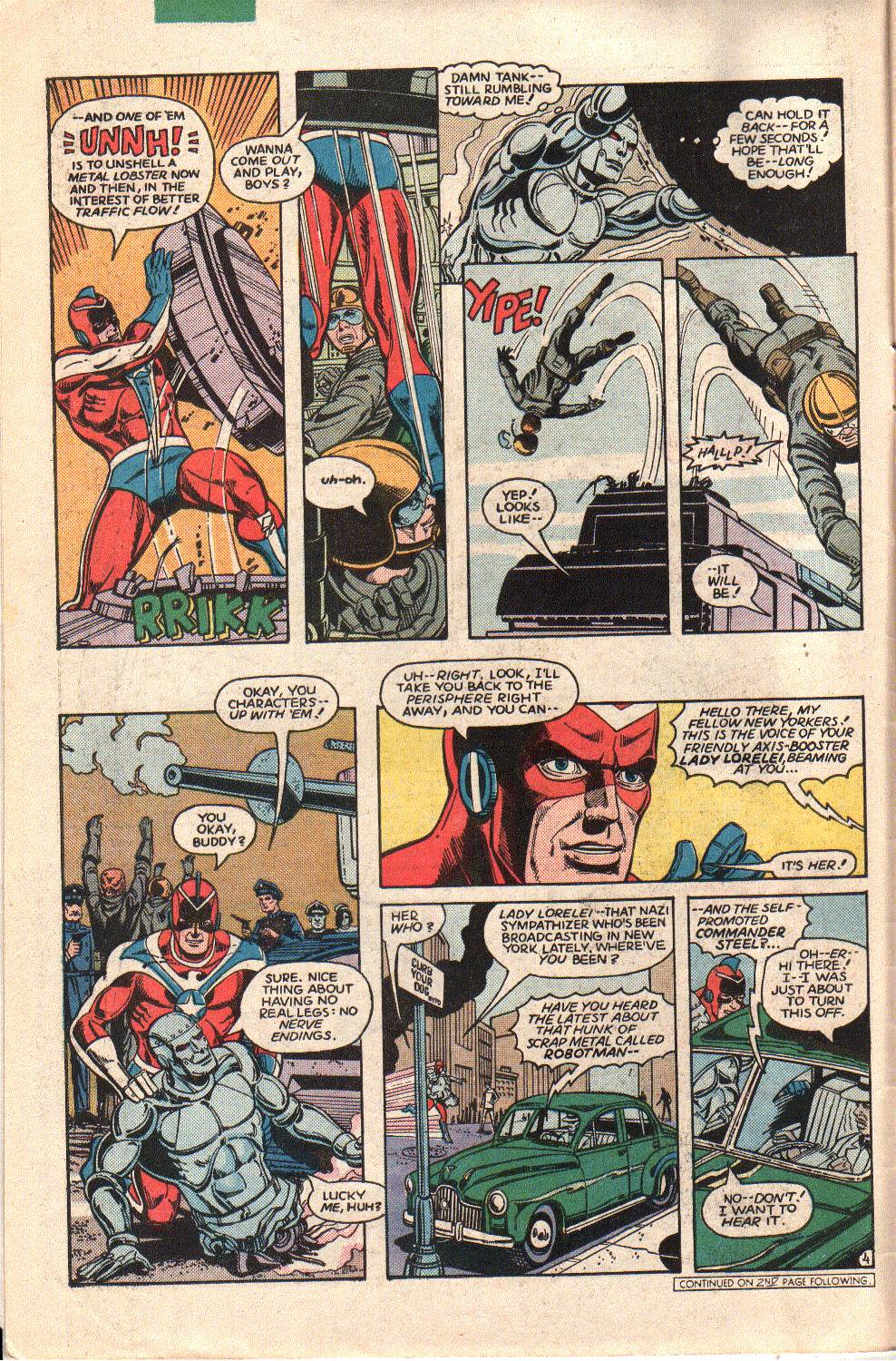 Steel helps Robotman to a cab, to return to the Perisphere and hears a propaganda broadcast by Nazi sympathizer Lady Lorelei. Steel hears that Capt Brad Farley is MIA. He is married to Hank Heywood's ex-fiancee, Gloria and he runs off to see her, towing Robotman's torso. he leaves him in an alley (!) and sees her. She is not too receptive, thanks to the death of her father and (she believes) Hank Heywood. Hany can't take it anymore and reveals himself to her and then makes a promise to find her husband and bring him home... 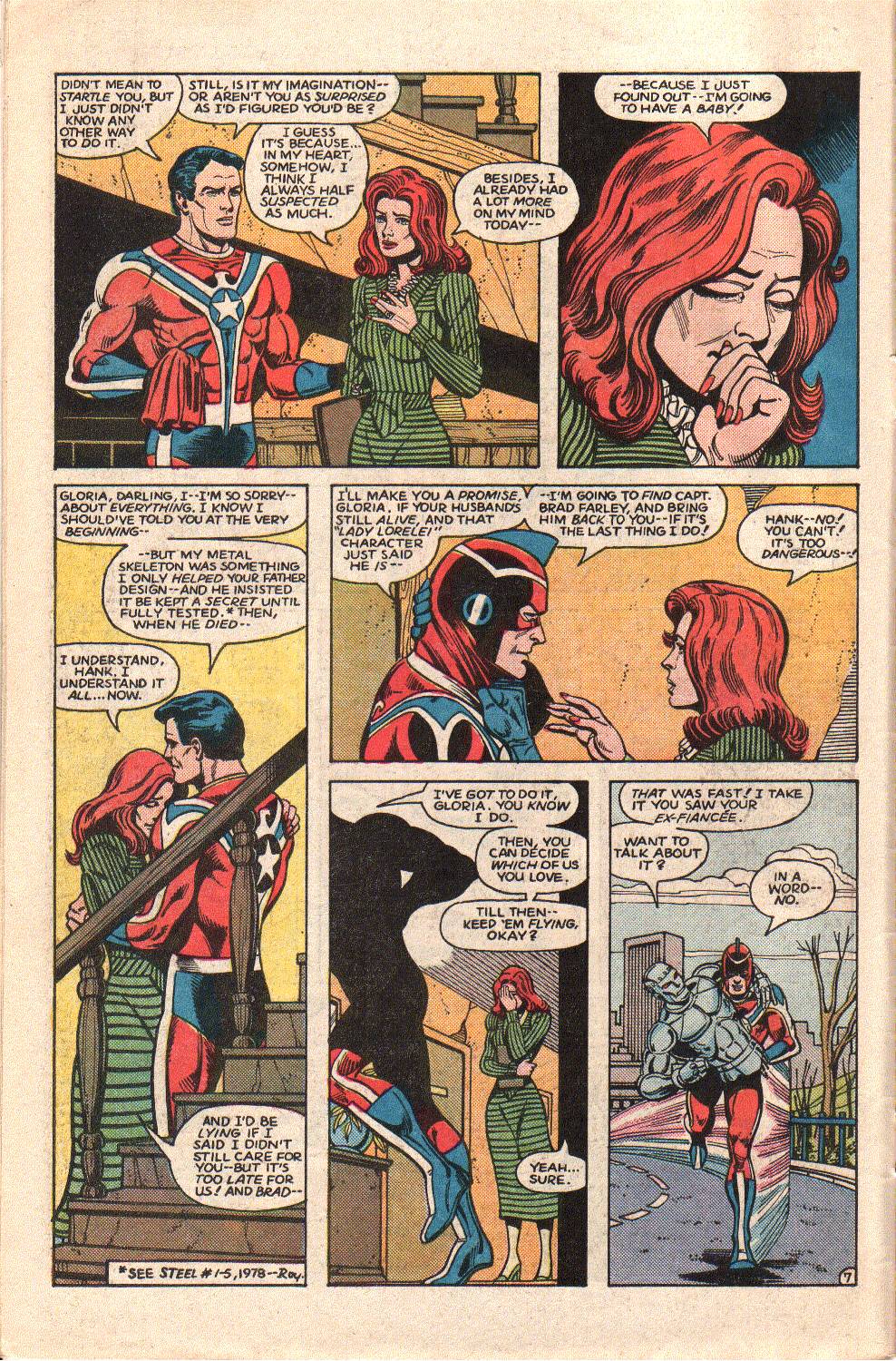 They return to the Perisphere and Robotman sets to work repairing himself and Hank runs into Liberty Belle, coming out of Johnny Quick's room, followed by Johnny, who is tucking in his shirt...  Awwwwkkwaarrrrddddd....... Johnny has some news reels that Tubby Wash assembled to catch up Hourman, after his time on Earth-X and the gang sits down to watch them, after catching up on their individual adventures. Firebrand, Tarantula and Hourman join the group and the turn on the projector. We see clips from Dec 1941, the JSA joining the Armed Forces, the fight against Dr Hastur, Hitler declaring war on the US, the battle in California, the fight with Ultra-Humanite's bunch, and shots of MacArthur, in the Philippines, and Johnny gives a higher assessment of Doug than some of his troops did. Johnny is gushing over Libby's work in California and everyone is picking up on the dynamics. Them Green Lantern turns up with new footage and tells them about the Marvel Family. He then pops in the reel and we see racial unrest in Detroit, at the Sojourner Truth Homes, a housing project that was set up for African-American families, which has the KKK, bundists ad other a-holes up in arms. A car takes a wrong turn and runs into a mob, and the passenger is a familiar face... 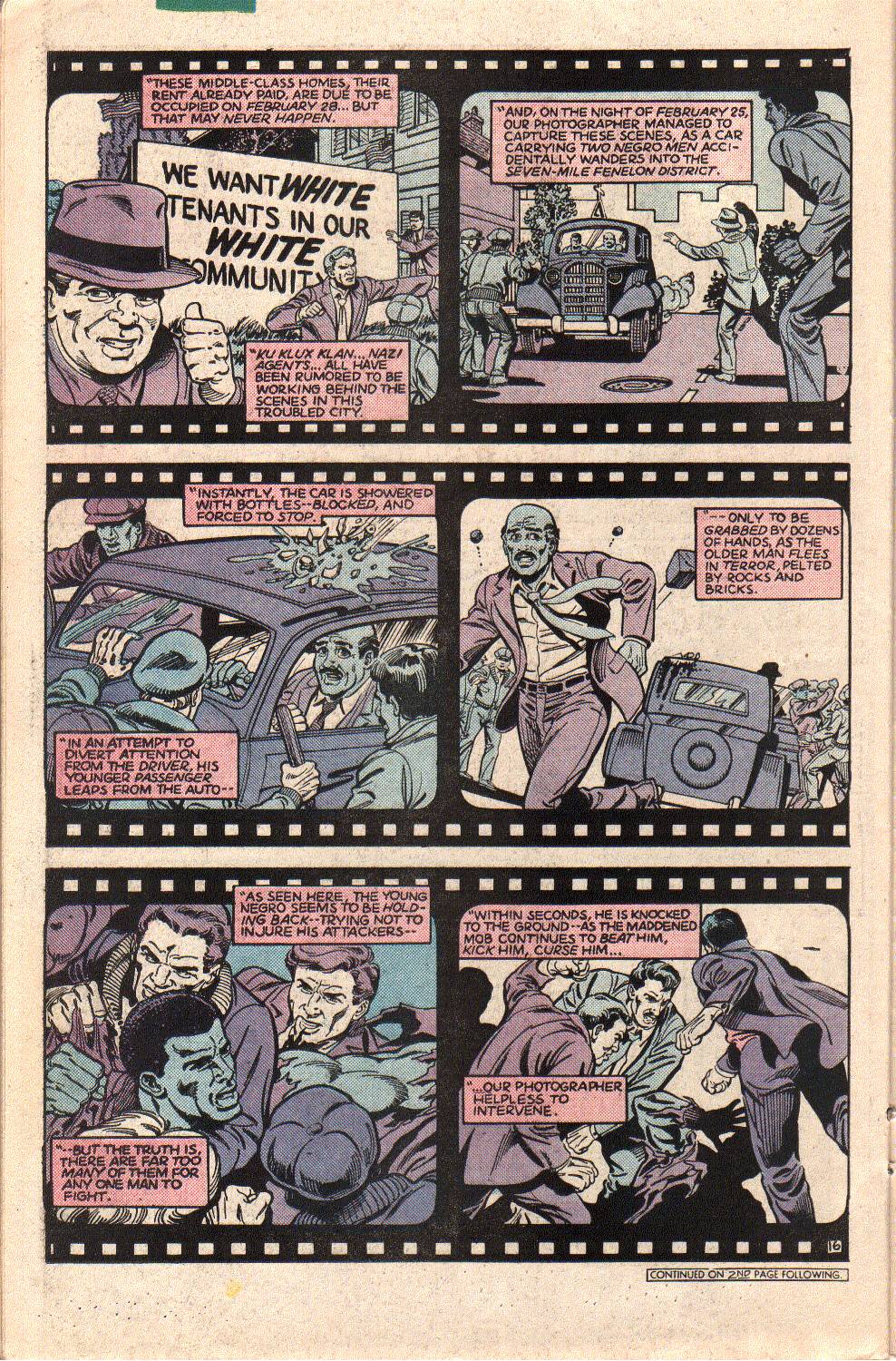 He is dragged off to some robed men, known as the Phantom Empire, who chain him to a wooden cross, douse him in gasoline and set him on fire.... 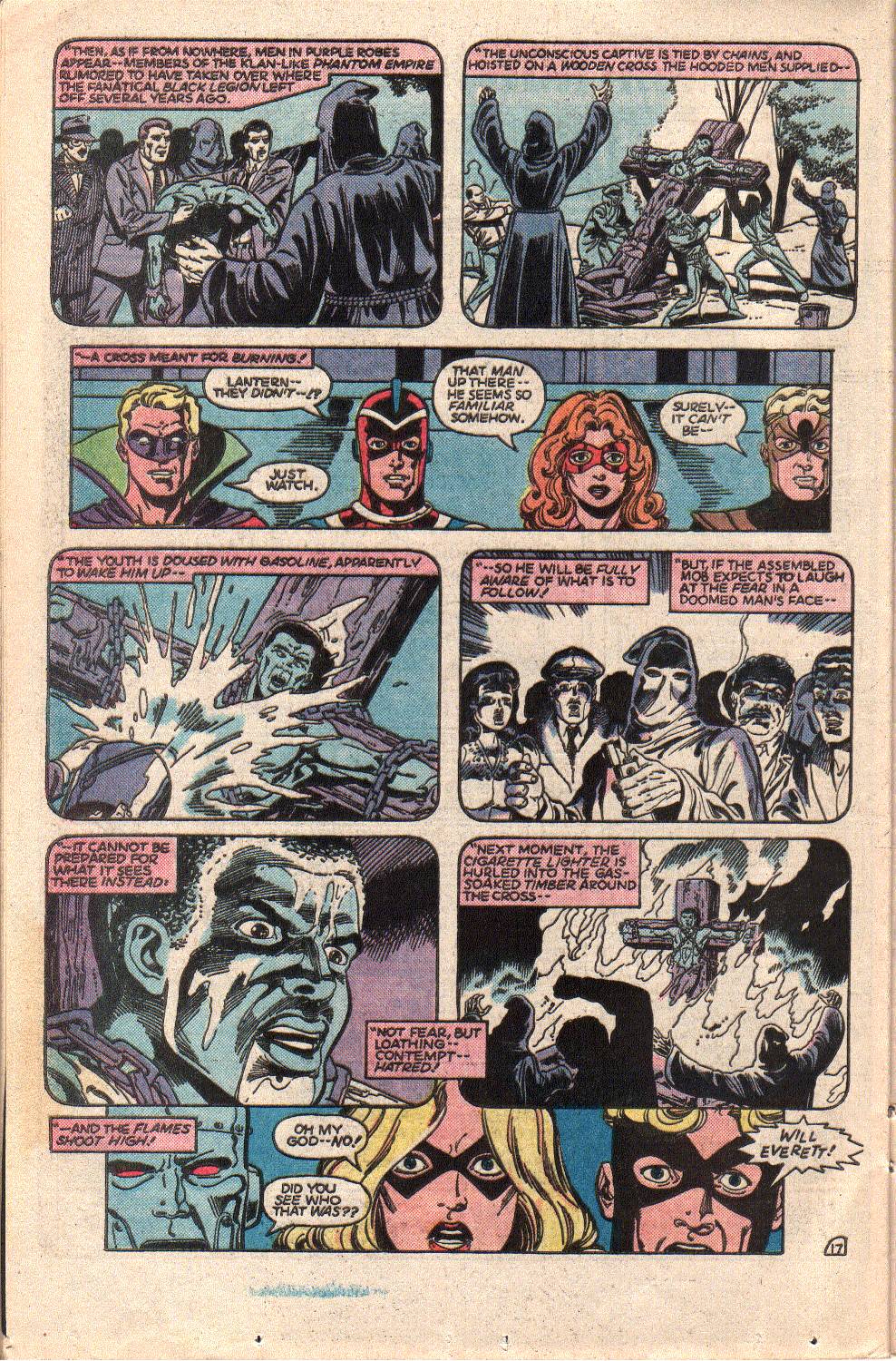 He transmutes into steel and breaks free of the cross and the mob scatters. Green Lantern proppes they head to detroit to help safeguard the homes, while CDR Steel heads to England, to begin the search for Gloria's husband. The All-Stars depart in their brand new, experimental All-Star Special... 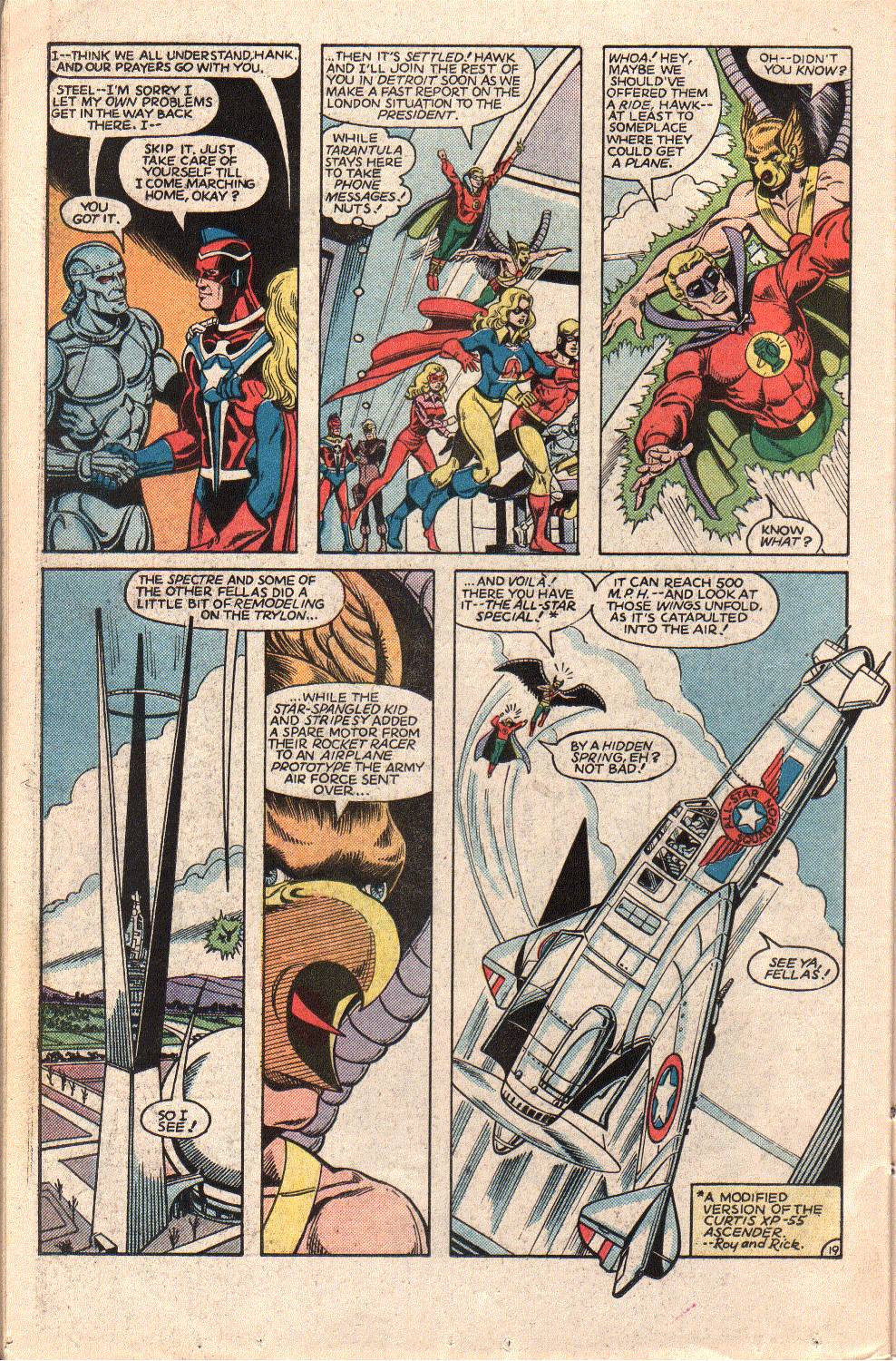 Meanwhile, in Detroit, a gathering of the Phantom Empire meets their new leader, Real American.... 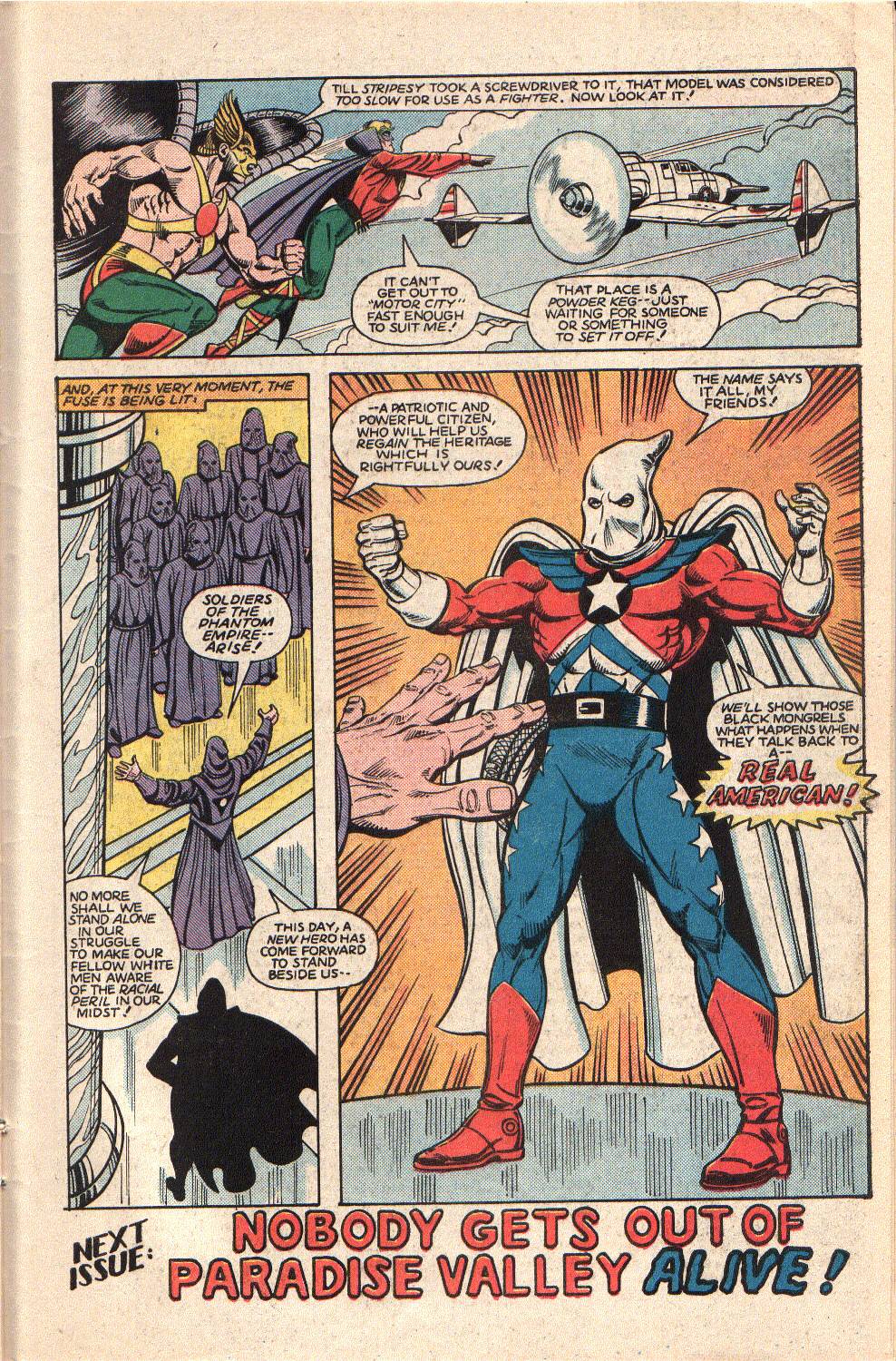 Doesn't look like Hulk Hogan, but given his recent history with racist comments, it might be fitting. Thoughts: Lot of subplot set up going on here, as Steel goes off on a crusade, while the rest head to Detroit. Johnny and Libby's romance is in full gear (hope he has some Rubber Johnnies). Meanwhile, Roy schools us on some real incidents, which I will get to, and finds the perfect story to highlight the new Amazing Man. The Phantom Empire takes its name from the move serial, starring Gene Autry (which is a hoot and I highly recommend it). The rest of it comes from the Humphrey Bogart film, The Black Legion, based on the actual vigilante group in Michigan, which was an offshoot of the KKK. The Klan actually tried to sue the film for trademark infringement, for the use of the Klan symbol, but a judge threw out the case. Remember what I said about Santayana? Hoberg's depiction of Robotman is interesting, as his jaw is rather different than previous renditions, making him loo a bit more like the Tin Man, if you ask me. We get a small, detail-less cutaway diagram of the Trylon and Perisphere and we later see the Trylon open up its apex to launch the Special. Have to say, they chose a fitting aircraft to use as their model for it (see below). This one is just getting started, as Roy is going to explore more of this country's racial past. Historical Notes: The All-Star Special, as Roy notes, is based on the Curtis XP-55 Ascender....  Herein lies a problem. The Army didn't issue a contract for prototypes until July, 1942 and the first test flight wasn't until a year later. At this stage of the game, there had only been wind tunnel tests and a full scale model. It was designed as a pusher plane, with the propeller in the rear. The advantage of this is a clear view ahead, for the pilot, which also allowed gun placement on the nose. The original design included two 20 mm cannon and 2 .50 cal machineguns, though the cannon would be replaced by .50 cal MGs, as well. Initial flights showed it needed a long take off, which led to modifications. What was never solved was the flight characteristics, which were substandard to existing fighter planes and jet aircraft were well along in development. It ended up as a unique design idea, in an era where aviation design was thinking outside the box. The design was used by James Robinson in a story he did for DC's Tangent mosaic event, with a Blackhawk--like group, led by Captain Boomerang, who flew planes based on the XP-55 design, whose wings formed a V-shape. The Germans also experimented with a similar aircraft, the Dornier Do-335...  and the Japanese were developing the Kyushu J7W Shinden....  Detroit was the heart of the auto industry and it was to become a center of defense work, as factories retooled to churn out jeeps, trucks, tanks, boats and aircraft. This led to a mass migration to the city, with over 400,000 migrating from the south, both whites and African-Americans. Detroit hat been a hotbed of KKK activity, especially in the 1920s, with the Black Legion. In 1941, the detroit Housing Commission proposed buil;ding the Sojourner Truth homes, for black defense workers. The site chosen was near the Seven Mile-Fenelon neighborhood, which was in close proximity to existing black neighborhoods, but also white ones. An association of both white and black residents of the area was formed to fight the project. This was largely fueled by the FHA refusing to guarantee the mortgages for the homes and existing home owners thought the project would lower their property values. The Federal government reversed itself a couple of times, at one point saying it would have white residents, then a couple of weeks later saying it would be for black war workers. Tensions built and, in February 1942, blew up, as the first families came to move in. There were mobs there to greet them, protesting against the homes and in support of them. tensions spilled over and fights broke out. Eventually, there were 40 injuries and 220 arrested. 109 went to trial, but only 3 whites. The city backed off of the move in, for 2 months, while tensions died down, then National Guard troops escorted the families as they moved in. This led future housing projects to be racially segregated and further use of threats of violence by white groups, to block any changes in racial residency. Tensions would continue to worsen, until full scale riots broke out in 1943, at a time where there were other race riots, in Beaumont Texas, Los Angeles (the Zoot Suit Riots), New York, and Mobile. As we can see in today's headlines, these divisions and incidents underlie a long pattern of bigotry and grievances that fuel modern tensions, as many areas have experienced systemic inequity, from housing, to government, economic conditions, police policies, education, and other social conditions. November 1942 Casablanca premieres in New York, on November 26. At Guadalcanal, US and Japanese naval forces continue their battles, with the 3rd and 4th Battles of Savo Island, in which the US suffers heavy losses, but maintains control over Guadalcanal. The Japanese lost the battleship Hiei, which greatly upset Adm Yamamoto, who relieved Adm Abe of command, afterward, both for not pursuing the battered Americans and retreating with the troop ships and supplies meant for Guadalcanal. Among the US losses was the cruiser USS Juneau, which was torpedoed, with only 100+, out of 697 crew, surviving. Among the dead were the 5 Sullivan Brothers (George, Frank, Joe, Matt, and Al), of Waterloo, IA. The Sullivans had written to the Navy Department for permission to serve together, which had been granted, with the end result that they all died together, leaving behind their parents, sister Genevive, and Al's wife and son. A destroyer would be commissioned in their name and a movie, dramatizing their lives, would be filmed, with Thomas Mitchell, Ann Baxter and Ward Bond.  The deaths of the Sullivans and the 4 Borgstrom Brothers (in 1944) led to the Sole Survivor policy, which protects families from conscription, if they have already lost family members. Prior to its enaction, there were instances where surviving sons were granted release from the military. These incidents would inspire the movie Saving Private Ryan. A second attempt was made to send in troops, in mid-November, which was attacked by aircraft from Henderson Field, the base at Espiritu Santo and the USS Enterprise, sinking 6 transports and heavily damaging and turning back another. Adm Halsey split off the USS Washington and USS South Dakota, and 4 destroyers to protect Henderson Field from naval attack, while he withdrew damaged ships. They encountered Adm Kondos group that had been escorting the transports, engaging in a night battle. Washington and South Dakota were new ships. They encountered the Japanese and the destroyers were sunk and the South Dakota experienced an electrical failure and was blind and unable to fire her batteries. She came under intense fire and had to withdraw. The Washington was tracking the Japanese destroyer Kirishima, but couldn't fire because of the South dakota. When the Kirishima opened fire on the South Dakota, the Washington was able to identify foe and opened fire and sank the vessel. Again, the Japanese had failed, though Yamamoto was kinder to Adm Kondo, a battleship man (like Yamamoto) than he was to Abe (a destroyer specialist). The Japanese gave up attempts to launch a full scale invasion of Guadalcanal to reinforce its dwindling troops and had to rely on the Tokyo Express, rapid night runs by a few warships to offload cargo and replacement troops, in ever decreasing numbers. Henderson Field continued to be expanded, housing fighters and bombers to take on Japanese forces from Rabaul and Truk, while Espiritu Santo. The appraoches to Guadalcanal meant navigating narrow channels in the Solomon Island chain, known as "The Slot," often at high speed, with little room to maneuver. These runs continued until the next year, before the final defeat at the Battle of Cape St George. Part of the forces that operated in the Solomon Islands were PT-Boat squadrons. These were smaller, high speed boats, armed with torpedoes, which would use radar to locate Japanese ships and launch torpedo attacks against the. The most famous of these boats was PT-109, commanded by LT(JG) John F Kennedy. Espiritu Santo is an island in the New Hebrides, which was used as an Allied supply base, naval harbor and airfield. Among the squadrons stationed there was Marine Corps VMF-214, better known as the Black Sheep, under the command of Maj. Gregory "Pappy" Boyington. The squadron was formed in 1942 and Boyington took command, after service in China, with the American Volunteer Group (the Flying Tigers). The squadron was later relocated to Henderson Field, then Munda, and Vella Lavella. Their legend was to come, in 1943. In Russia, the Red Army, under Gen Zhukov, launch Operation Uranus, a mass counter-attack, designed to relieve the Siege of Stalingrad. The Germans had been in sectors longer than anticipated, with supply issues. Forces had also be reallocated to the west. Many of their forces were from allied nations of Romania, Hungary and Italy. The Russians launched a mechanized offensive and bypassed some German formations to press their attack on the weaker areas, particularly the Romanians. Soviet production had meant that the Russians were able to field large tank forces, supported by infantry and artillery. The operation began on the 19th and the Romanians, after stiff initial resistance, were in full retreat. By the 23rd, the Russians had encircled the German 6th Army, which requested permission to withdraw and were denied by Adolf Hitler. The besieged troops were resupplied by air. The Luftwaffe was not up to the task ad could only supply about 20% of the required ammunition, fuel and food necessary, between a lack of aircraft and ever increasing attacks by Russian fighter squadrons. The British won the Battle of Madagascar, when Vichy forces surrendered. The British had attacked the island to prevent its use by the Japanese. The surrender of French territory to the allies was just a prelude for what was to come. Off Oran, Algeria, the USAAF intercepts Luftwaffe patrols and destroys them. The next move was an even bigger surprise. On November 8, the Allies launch Operation Torch, under the command of Gen Dwight D Eisenhower. The aim was to gain a foothold in French North Africa and then drive eastward, creating a pincer movement that would trap the Afrika Korps between the American advance and the British advance from Egypt. In advance of landings, the US had secretly met with French commanders, to persuade them to abandon the Vichy government and allow the landing to be unmolested. Gen Mark Clark traveled via submarine and met with these commanders in secret. The landings would be conducted only by US troops, due to the past history between Britain and France, including the sinking of the French fleet. Simultaneous landings were undertaken at Casablanca, Oran and Algiers, the major centers of Morocco and Algeria. At Casablanca, no shor bombardment was attempted and the French fired on landing forces. a pro-Allied general, Antoine Bethouart, attempted a coup against the Vichy commander, but was stopped. After 2 days, Casablanca surrendered. At Oran, poor pre-invasion reconnaissance led to beached and damaged ships, while stiff resistance, including a sortie by french ships, bogged down the invasion. The US Army Rangers landed and captured shore batteries at Arzew, but an attempt to land quickly at the port failed. British ships engaged in a gun battle with shore batteries, after driving back the French sortie (and sinking parts of it), which lasted until the following day. Oran surrendered on the 9th. The first US Airborne operation was carried out, with the 509th Parachute Infantry regiment dropped to capture airfields near Oran. The long flight path led to issues, plus poor navigation, in part due to a ship broadcasting on the wrong frequency,. Some of the C-47 Dakotas dropped troops in morocco and a group was dropped over Spanish Morocco and was interned by Spanish troops, until February, 1943. At Algiers, the landings went far better, as French resistance troops, mainly 400 French Jews, launched a coup in the city and seized control of the telephone exchange, radio station, governor's house, and garrison HQ. They neutralized the shore batteries and troops landed virtually unopposed, though a British ship that attempted to land Rangers to seize the port came under heavy fire. The Allies made a deal with French general Darlan, who ordered all French forces to cease resisting the allies and fighting swiftly came to an end. Hitler ordered the German army to occupy Vichy France, in violation of their treaty and assumed full control over all of France. Tunisia remained in Axis hands, as Vichy forces did not fight the Germans and Italians, who built up their defenses. Meanwhile, Montgomery continued his advance on Rommel and the British captured Tobruk, on Nov 13, and Benghazi, on the 20th. In Greece, the Special Operations executive (SOE) and Greek resistance succeed in destroying the Gorgopotamos viaduct. The mission was undertaken to disrupt German supply lines through Greece, which were ultimately bound for North Africa and Rommel. The purpose was rendered moot, after Rommel was defeated at El Alamein; but, it bolstered Greek morale and set a precedent for further sabotage operations in occupied territory, using the SOE and OSS, coordinating with local resistance groups. these operations would go on to form the basis for US Army Special Forces, modeled on the Jedbburgh teams fielded by the OSS, who worked with resistance groups (following the SOE model). It would also be the last time that the Greek resistance groups, the EDES (nationalist) and ELAS (left wing) would cooperate, as they, like the Yugoslav and French resistance groups, who would fight battles among themselves, as well as the Germans. It broke out into full scale civil war, in 1946. At Toulon, the French Navy scuttled their fleet stationed there, before the Germans could seize the ships for use against the Allies. The fleet had been interned there, after the French surrender, but, Operation Torch and the occupation of Vichy France led to the German order to assume command. The events in North Africa cause political issues within the Allies, as De Gaulle was angered that the Free French were not included in planning and had no role in governing North Africa, particularly after Adm Darlan defected to the Allies and was given political leadership in the region, maintaining former Vichy ties. However, many former Vichy institutions turned their allegiances to the Free French. In many ways, it was a continuation of the same political squabbles that hindered France in fighting the Germans and led to their defeat, as well as their post-war turmoil. The Allies had smuggled out French general Giraud, to convince the Vichy troops to lay down arms; but he refused to cooperate and broadcast messages, unless he was given command of the invasion. He sat in Gibraltar listening to the progress, before he was shamed into aiding, after it had any meaning. The stereotype of French surrender is BS; it's soldiers fought as hard as anyone; but, its generals were another matter, as arrogance and ego far outweighed professionalism and pragmatism. The US had similar problems in the pre-war days, though necessity weeded out the bad and led to the rise of the good.
|
|
|
|
Post by codystarbuck on Sept 9, 2020 16:42:51 GMT -5
Why should Batman be cool with a couple of kids, one on crutches, walking deep in the heart of Nazi Country? After all, he decided to recruit a teenager (what is Robin at first, like 13) to help him fight dangerous, armed criminals. Robin at least was a trained acrobat, who gained combat training, before going into battle. These are two random kids, one on crutches. The kicker is, if they say their magic words, their super-powered selves immediately fall under the Spear of Destiny; so, it's not like they add any strength there, other than being able to recognize Billy. |
|


